Robert Colescott

Life in colour
Roger Moore
Nobody does it better
Formula 1
Lotus 79: black and gold, fast and beautiful
Ithell Colquhoun
In her surreal world and Princess Diane de Beauvau-Craon
Queen of the night
MAGAZINE AUTUMN 2023 ISSUE 76 AUTUMN 2023 ISSUE 76 MAGAZINE
Design
London
Tuesday 3 October 2pm
Hans Coper (1920-1981)
Early and large 'Thistle' form, circa 1952
Stoneware, layered white porcelain slips and engobes over a body with textured and incised linear designs, the interior with manganese glaze

46.2 x 43 x 21.5cm (18 x 17 x 8½in)
Impressed with artist's seal
Estimate: £50,000 - 70,000 ($65,000 - 90,000)
Enquiries: Marcus McDonald +44 (0) 20 7468 5864 marcus.mcdonald@bonhams.com
Post-War & Contemporary Art
London
Thursday 12 October 4pm
Alighiero Boetti (1940-1994)

TUTTO, 1988-1989
Embroidery on canvas
141 x 91.5cm (55½in x 36in)
Estimate: £700,000 - 1,000,000
($900,000 - 1,200,000)
Enquiries: Irene Sieberger
+44 (0) 20 7468 5873
irene.sieberger@bonhams.com
19th Century British and Impressionist Art
London
Wednesday 27 September
2pm
Sir Alfred James Munnings, PRA, RWS (British, 1878-1959)
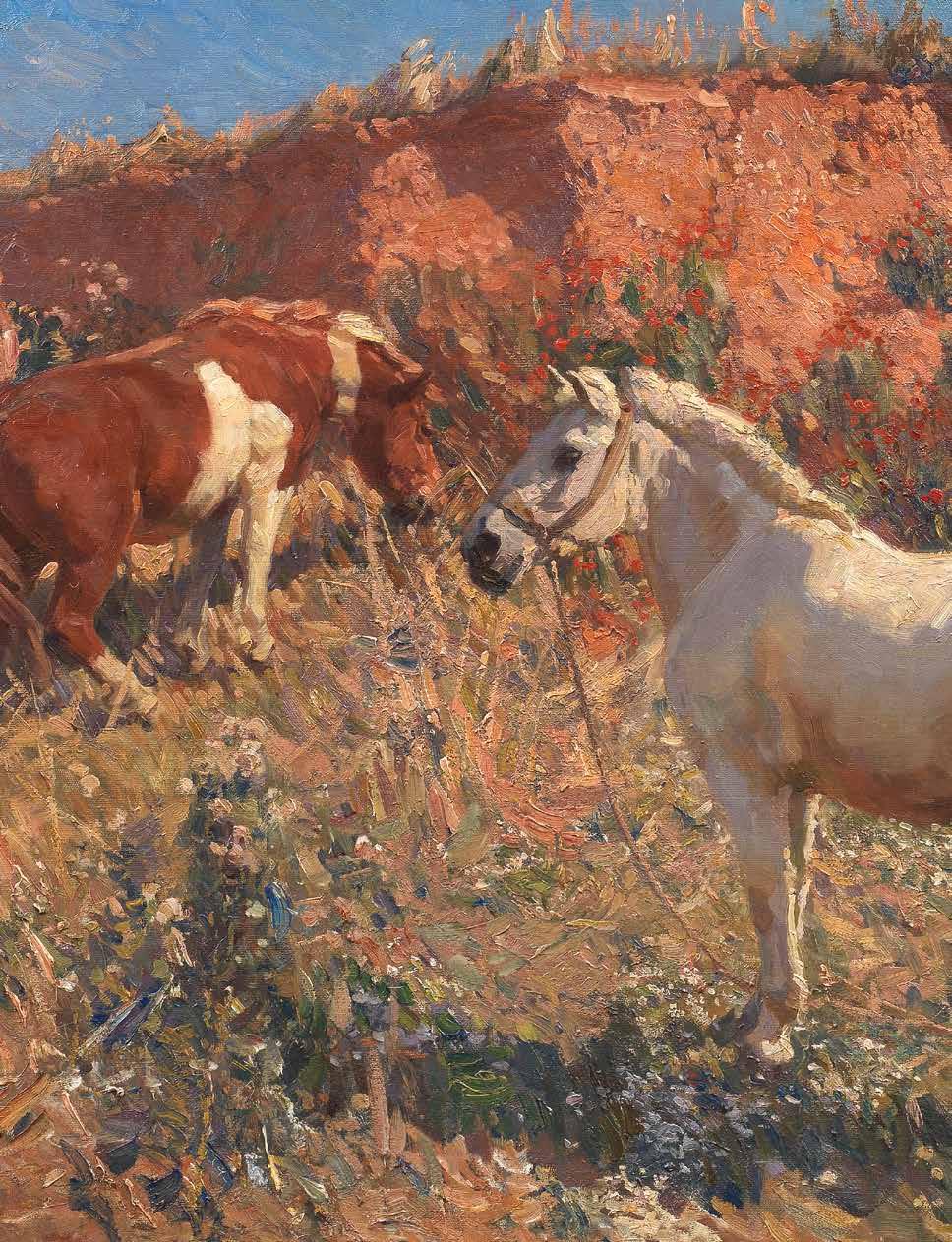
The old gravel pit, Swainsthorpe (detail)
oil on canvas
76.2 x 127cm (30 x 50in)
Estimate: £300,000 - 500,000
($400,000 - 650,000)
Enquiries: Charles O’Brien +44 (0) 20 7468 8360
charles.obrien@bonhams.com
Contents
5 Editor’s letter and contributors
Features
18 A head of the curve
Henry Moore was the miner’s son who took British sculpture to the world. Mark Hudson explains how global success hid profound inner turmoil

22 Life in colour
Told he was born in the wrong skin, Robert Colescott first felt at home in Egypt. Matthew Weseley reveals the secrets that drove his vivid, satirical paintings
26 Metal guru
Where did the masters of modern art go to create pieces of gold?
Kate Youde talks to Nicolas Hugo from Ateliers Hugo about how his grandfather worked with artists
30 The eyebrows have it
Ryan Gilbey salutes the best Bond, a man as urbane in real life as he was in his most-famous movie role
36 Living the dream
Many women fought for self-expression between the wars, but none was more extraordinary than surrealist and occultist Ithell Colquhoun, argues Alyce Mahon
40 In at the deep end
Harry Fisher applauds Greg Louganis, the diver who won multiple Olympic Golds – before starting his life’s work
44 French connection
Thanks to the savage persecution of the Huguenots in France, Susan Moore recounts how Dutch furniture found a new direction
48 Here comes the night
She partied at Studio 54, lived with Robert Mapplethorpe – and survived to tell many tales. Lucinda Bredin meets Diane de Beauvau-Craon
52 Mortal fear
Sasha Thomas finds the one thing on which artists of all ages can agree: the obsession with death
54 Real Madrid
Paul Richardson has a behind-thescenes tour of the new Royal Collections museum in Madrid
58 Crossing the line
Has there been a greater sight in all motorsports, asks Richard Williams, than black-and-gold Lotus 79s racing neck-and-neck?
Columns
7 News and forthcoming events
15 Inside Bonhams
May Matthews, Managing Director of Bonhams Scotland, tells Hongmiao Shi about the thrill of one special bid
63 Wine
Lucinda Bredin goes on the full English experience of the Sussex wine trail
65 Around the globe
70 International directory
72 My favourite room
Philippe Stoclet on the palace his grandfather built
Front cover
Robert Colescott (1925-2009)
1919 (detail)

1980
acrylic on canvas
182.3 x 213.2cm (71¾ x 83⅜in)
Estimate: $3,000,000 -5,000,000 (£2,500,000 - 4,000,000)
Sale: Robert Colescott
New York | Friday 8 September
See page 22
Bonhams Magazine | 3
Issue 76
18 36
Impressionist & Modern Art
London
Thursday 19 October
5pm
Wassily Kandinsky (1866-1944)

Milieu jaune (detail)
Painted in Paris in March 1934
oil and tempera on panel
64.6 x 81.3cm (25½ x 32in)
Estimate: £850,000 - 1,250,000
($1,000,000 - 1,600,000)
Enquiries: Ruth Woodbridge
+44 (0) 20 7468 5816
ruth.woodbridge@bonhams.com
Editor’s letter
Is there such a thing as a person defining an era? I ask because this issue has brought together a number of extraordinary people who made an indelible mark on the age in which they lived.
But the flip side of the coin is to wonder if that era has also limited their ambitions through prejudices such as racism and sexism. How different things might have been if they had been allowed to flourish without obstacles placed in their path. In the case of the artist Ithell Colquhoun, a Surrealistcum-occultist of the 1930s, it is only now that she is being given the attention she deserves, and we can see how the era confined her as much as it defined her. Colquhoun studied at the Slade School of Art, but rejected her formal training and embraced the wider shores of Surrealism. Membership even of this notoriously erratic group was fraught – she was expelled for dabbling in the occult. However, there is a case to be made, says Alyce Mahon, that this freed Colquhoun to pursue her own path to create works “entangling magic and the marvellous”.
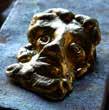
Segregation in the US poisoned lives. One artist who suffered from this iniquity was the Black painter Robert Colescott, whose
Contributors
Ryan Gilbey writes about film for The Guardian, and won a Press Gazette award for his columns at the New Statesman



He is currently writing a book about queer cinema for Faber, and previously wrote It Don’t Worry Me which is about 1970s US filmmakers, as well as a critical study of Groundhog Day. On page 30, Ryan pays his respects (eyebrow raised) to Roger Moore.

Richard Williams
Richard is a former chief sports writer of The Guardian. His books on motor racing include The Death of Ayrton Senna, The Last Road Race, A Race with Love and Death, biographies of Enzo Ferrari and Stirling Moss, and, most recently, 24 Hours: 100 Years of Le Mans (Simon & Schuster). He recalls the groundbreaking Lotus 79 on page 58. His music blog is thebluemoment.com
Follow us on Twitter: @bonhams1793; email: press@bonhams.com


mother chose to raise her two sons as white. It was a cloud over Robert’s life that only began to lift when he went to Egypt and first felt at home. His work from the 1970s aimed at exorcising the racism he had experienced, by putting Black figures front and centre in his paintings. His masterpiece 1919 , to be offered in New York in September, shows his parents either side of a map of the US – it is the most revealing and personal of all his works. Did Roger Moore invent the 1970s? Or did the decade create him? Few can think of the era without Moore’s epoch-defining safari suits, and Dougie Hayward’s sharp tailoring obviously helped Moore’s James Bond climb the Eiffel Tower in full dinner dress and defeat Grace Jones’s devastating May Day. Now you too can own a piece of the magic by bidding in the Sir Roger Moore Collection sale in October. Ryan Gilbey reminds us just how deft the master of the eyebrow was.

The ’80s itself is the subject of a sale in Paris. To mark it, I’ve interviewed one of the great survivors of that decade: Princess Diane de Beauvau-Craon. The stories, m’dear! Turn to page 48…

Alyce Mahon

Alyce has published books on surrealism, de Sade and eroticism in art. Head of the University of Cambridge Department of History of Art, she co-curated SADE: Freedom or Evil at CCCB and curated the first major retrospective of Dorothea Tanning for the Reina Sofia and Tate Modern. She writes on another remarkable female surrealist, Ithell Colquhoun, on page 36.
Kate Youde

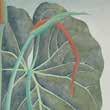
Kate is a freelance journalist who writes for leading publications including the Financial Times Covering topics across the areas of design, heritage, the arts, watches and jewellery, her work has appeared in the V&A magazine, The Times, The Daily Telegraph, Spectator Life, and many more. On page 26, she explores the artistic collaborations of the goldsmiths Ateliers Hugo.
Paul gives us a preview of Madrid’s newest museum on page 52. He settled in Spain in 1989, where he lives off-grid on a farm in Extremadura. His books include Our Lady of the Sewers A Late Dinner and, most recently, Hidden Valley He writes for the Financial Times and The Daily Telegraph and is a contributing editor for Condé Nast Traveler and Gourmet
Editor Lucinda Bredin Editorial Sasha Thomas, Hongmiao Shi, Hannah Daniells-Conroy Copy Editor Simon Coppock Designer Nathan Brown Assistant Designer Cristina Santos Photographs Bonhams Photography Advertising Enquiries renata@parkwalkmedia.com Published
No part of this publication may be reproduced, stored in a retrieval system or transmitted by any form or by any means, electronic, mechanical, photocopying, recording or otherwise without the prior written permission of Bonhams. All dates are correct at the time of publication. All sales are subject to Bonhams Terms & Conditions. Sale dates may be subject to alteration. Currency exchange rates correct at the time of publication. bonhams.com. Should you no longer wish to receive this magazine, please contact jacqueline.senior@bonhams.com
Bonhams Magazine | 5
a
Bond Street,
W1S 1SR Subscription (four issues)
Subscription Enquiries
ISSN 1745-2643. Issue 76 © Bonhams 1793 Ltd,
four times
year by Bonhams 1793 Ltd, 101 New
London
£25 for the UK, £30 for Europe or £35 for the rest of the world, inclusive of postage.
jacqueline.senior@bonhams.com;
2023.
Ryan Gilbey
Paul Richardson
Prints & Multiples
Los Angeles
Tuesday 3 October 10am
Bridget Riley (born 1931)
Composition with Circles 4 (detail)
2004
Inkjet print
22 x 99¼in (56 x 252cm)
$15,000 - 20,000
(£12,000 - 16,000)
Pablo Picasso (1881-1973)
A collection of ceramics

Estimates range from $3,000 - 12,000
(£2,400 - 9,400)
Enquiries: Morisa Rosenberg
+1 323 436 5435
morisa.rosenberg@bonhams.com
News
In and out of Bonhams’ salerooms



Crucible of change
In the Middle Ages, alchemy was about turning the impossible into reality. Helen Frankenthaler (1928-2011), one of the greatest American artists of the 20th century, brought this into the modern era. In 1963, she began to experiment with thinned acrylic paints, which were easier to work with than thick, opaque oil paints. Developing her ‘soak stain method’, Frankenthaler changed the rules of abstraction. In Alchemy, she imbues the abstract with a sense of naturalism, creating a dramatic interplay of fiery red colours that ebb and flow against a cool backdrop. Estimated at $2-3 million, the work will be previewed in London in September as part of the Abstraction exhibition at New Bond Street, before going under the hammer during the Post-War & Contemporary Art sale this November in New York.
Enquiries: Andrew Huber +1 917 206 1633 andrew.huber@bonhams.com

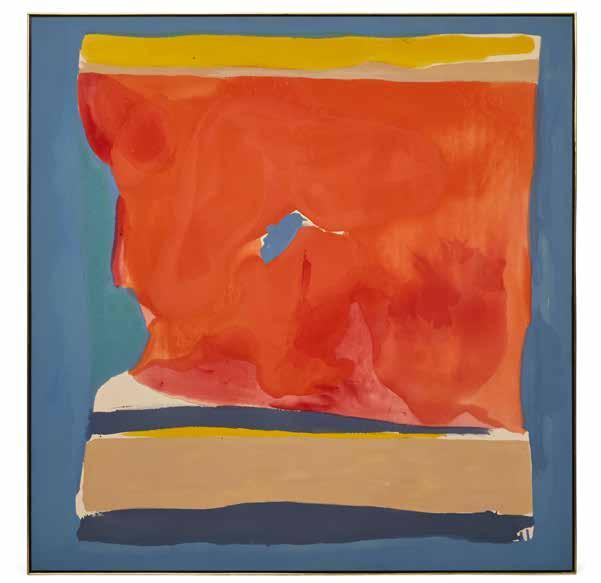


Talented Monsieur Delon
When asked what he wanted his legacy to be, the French movie star Alain Delon replied: “My acting career and my art collection.” The former was already set in stone by his mid-20s, when he shot to fame as the charismatic young conman Tom Ripley in Plein Soleil (the French adaptation of Patricia Highsmith’s novel The Talented Mr Ripley). And the latter is finally getting the recognition it deserves. On a warm June evening, the beau monde of acting and collecting gathered at Bonhams Cornette de Saint Cyr in Paris for a cocktail reception celebrating Delon’s collection – which had just returned from a world tour spanning Brussels, New York, Hong Kong and Geneva. Partygoers came from Switzerland, Italy and beyond for a peek at works by Raoul Dufy, Eugène Delacroix, Rembrandt Bugatti and other masters. A few days later, Delon’s collection sold for a total of €8 million, double its pre-sale low estimate.
Bonhams Magazine | 7
O O
Frank Cicurel and Anouchka Delon Guest book
Mr and Mrs Hans-Kristian Hoejsgaard
Anthony, Anouchka and Alain-Fabien Delon
Didier Imbert and Emilie Millon
Erik and Virginie Maris and Arnaud Cornette de Saint Cyr
Post-War & Contemporary Art X Made in California
Los Angeles
Wednesday 13 September
12pm
Ed Ruscha (b.1937)
Gem, 1968
pastel and pencil on paper
11¼ x 28¾in (28.6 x 73.1cm)
Estimate: $700,000 - 1,000,000
(£540,000 - 760,000)
Enquiries: Kate Rosenheim
+1 323 436 5581
kate.rosenheim@bonhams.com

Out of the bag
What do you associate with the Hermès brand? Birkin, Kelly and Constance handbags, silk scarves and the orange boxes, no doubt. What about cigarette boxes, belts and golf-score clickers? It is unlikely that anyone beyond the true Hermès connoisseur would have these in their top five answers. Yet they all embody the fashion house’s quality and craftsmanship in miniature, and two single-owner collections featuring just such accessories will be offered in Paris on 30 and 31 October. The first, comprising nearly 300 rare pieces of early jewellery, bags and decorative objects, belongs to Hermès expert Geneviève Fontan –author of Carrés d’art, the three-volume study of Hermès scarves. The second, Collection Carrés Hermès, is dedicated to the house’s scarves (many of which feature in Carrés d’art). The company’s founder Thierry Hermès (180178), whose dedication to discreet, first-rate detailing like the saddle stitch underpins its success, would no doubt have recognised both collectors as kindred spirits.
Enquiries: Hubert Felbacq +33 1 56 79 12 45 hubert.felbacq@bonhams-csc.com

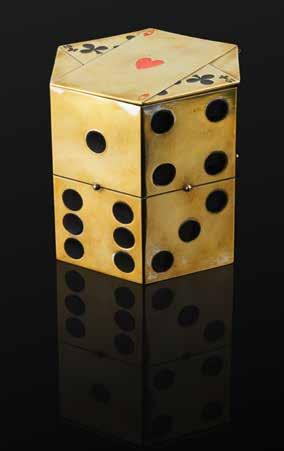
Head space
According to a recent NHS survey, one in five people aged 17-24 in the UK had a probable mental disorder in 2022. Yet mental health resources are more stretched than ever. The charity Hospital Rooms works with internationally renowned contemporary artists to help make NHS mental health units uplifting and inspiring spaces that support recovery. Last year, Hospital Rooms collaborated with Hauser & Wirth gallery on an exhibition and fundraising auction – hosted by Bonhams – that raised £325,000. This September, the collaborators return with an exhibition titled ‘Holding Space’, as well as another series of charity auctions – again, hosted by Bonhams. The funding from this year’s sale, featuring works by artists including Martin Creed, Chantal Joffe, Julian Opie and Sutapa Biswas, will support the Children and Adolescent Service in Sandwell, among other projects. The saleroom auction takes place on 12 September, with its online counterpart running from 1 to 13 September. All the art will be displayed at Bonhams New Bond Street in London from 4-12 September.

Enquiries: Cassi Young +44 (0) 20 7468 5815 cassi.young@bonhams.com

Double vision
Visitors to Barcelona are greeted by many impressive structures, but since the early 1980s three of the most striking have been colourful sculptures by the artist Joan Miró (1893-1983). In Parc Joan Miró, the 22m-tall Dona i Ocell (‘Woman and Bird’), covered with tiles by the artist’s collaborator Joan Gardy Artigas, is one of Miró’s most-celebrated creations. As the name suggests, the work explores the familiar Miró motifs of women and birds, but there is a more subversive possibility: in Catalan the word for a bird (ocell) is also slang for the penis – which might indeed be reflected in the phallic shape of the sculpture. Whatever you see, a smaller version of the work, which has never before been offered at auction, leads the Impressionist and Modern Art sale this October in London.
Enquiries: Ruth Woodbridge ruth.woodbridge@bonhams.com

O NEWS
O
O
Sutapa Biswas, Atrium, Springfield Hospital. Photo © Hospital Rooms (Damian Griffiths)
Impressionist & Modern Art
New York
Wednesday 15 November 1pm
Joaquín Sorolla Y Bastida (1863-1923)

Playa de Valencia (detail)
Painted in 1910 oil on canvas
18¾x 22in (48 x 55.9cm)
Estimate: $250,000 - 350,000 (£195,000 - 275,000)
Enquiries: Emily Wilson +1 917 206 1627 emily.wilson@bonhams.com
Man of the world
For the Peter Green Collection auction in June, Bonhams turned up the volume to honour the legendary guitarist and songwriter. The evening preview was packed with fans and collectors, alongside Green’s family, in a room filled with more than 130 of Green’s guitars, alongside other personal items such as amps, plectrums, sketchbooks and handwritten lyrics from the singer’s Fleetwood Mac days. It was one of the busiest parties at Bonhams, with live music from Ronnie Scott’s regulars Paul Stacey & Friends, who covered Green’s songs; a workshop from Crimson Guitars; and a chance to buy Green’s limited-edition book The Albatross Man. Jamie Dickson, Editor of Guitarist magazine, gave a talk with That Pedal Show about meeting Green and how he struck a chord with music-lovers. Proceedings reached a crescendo on 28 June when the auction soared past its expected result – with guitars like Green’s National Duolian Resonator Guitar selling for ten times its pre-sale low estimate – to total over £483,000.

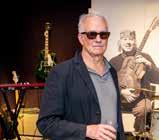




O Stirred, not shaken
Drinking and driving are never an advisable partnership – except in the case of the Martini Racing-Porsche sponsorship. Between 1971 and 1977, the team won Le Mans three times with the Porsche 917, the Porsche 936 Spyder and the Porsche 935, each of which combined stability on the track with exceptional speed. In other years, Martini-Porsche still gave the competition a run for their money: the 911 Carrera RSR Coupe held its own against three Formula 1-derived sports-
“Must put it all down here”
‘For Mary with Germanic and sentimental affection’: so wrote John Steinbeck (19021968) in a first edition, first issue copy of The Pastures of Heaven – his second published work – to his beloved younger sister Mary Steinbeck Dekker. Steinbeck’s grandfather was German, but the writer and his three sisters grew up in California’s Salinas Valley. In October, this lovingly inscribed book will be offered alongside other items from Steinbeck Dekker’s collection – the last substantial Steinbeck archive to be offered at auction. It includes unpublished diaries – one diary entry reads: “Must put it all down here and then some day burn this book…” – letters, and presentation copies – including a first edition of Tortilla Flat (‘For Mary with Bill – with love’) and a copy of Robert Bennett’s The Wrath of John Steinbeck (‘This is a god damned lie’) – as well as sentimental, personal items such a lock of three-year-old Steinbeck’s golden hair.
Enquiries: Catherine Williamson catherine.williamson@bonhams.com

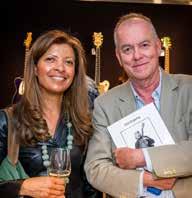
prototype cars to come fourth at the 1973 Le Mans. This September, that plucky car, known as the ‘R7’, will be offered at Goodwood Revival. It is thought to be only one of four surviving MartiniPorsche RSR works-team cars from the original group of eight, and the best preserved.
Enquiries: Mark Osborne +1 415 503 3353 mark.osborne@bonhams.com

O
NEWS O
Orientalist Art
London
Tuesday 25 October
3pm
Jean-Léon Gérôme (French, 1824-1904)
The Nile in flood, Thebes (detail)

Circa 1856-7 oil on canvas
78.1 x 116.9cm (30¾ x 46in)
Estimate: £80,000 - 120,000
($100,000 - 160,000)
Enquiries: Thomas Seaman + 44 (0) 20 7393 3960
thomas.seaman@bonhams.com
Bright star
Adopting an ‘art name’ is established practice in East Asian countries, where an artist, poet or writer selects – or is bestowed – a professional penname that reflects their values and ideals. Seongheui Kim was given the art name ‘Hemyeong’, meaning ‘charitable’ and ‘bright’ – a fitting alias for an artist whose paintings shine off the paper like a constellation of stars. Their inspiration comes from her idea of ‘cosmo social philosophy’, where the give and take of birth and death connects all things across the universe. Well established in Korea, where she not only exhibits regularly but is also a professor at Seoul National University’s College of Fine Arts, Hemyeong is little known outside her home country. Her art will be exhibited in London for the first time from 7-13 October as part of Bonhams’ Frieze Week events.

Enquiries: Bianca Dolfin +44 (0) 20 7393 3886 bianca.dolfin@bonhams.com

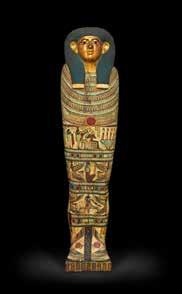
Readers re-Joyce
James Joyce (1882-1941) spent 17 years working on his fiendishly inventive final novel, Finnegans Wake Excerpts were published in a number of different literary magazines under the title ‘Work in Progress’, before the entire book was finally published in 1939, perplexing even the literati. “As far as I can make out, it is not about anything at all,” opined a contemporary reviewer for The New Yorker. In Britain, The Guardian was more thoughtful: “the work is not written in English, or in any other language, as language is commonly known.” Joyce himself reportedly said that he had created Finnegans Wake “To keep the critics

Going, going… Saigon

“Shirley, you’ll be closed in six months” was the horrified response of Shirley Hui’s friends. It was the early 1990s and she had just opened a gallery dedicated to Vietnamese contemporary art – a first for Hong Kong. Naysayers be damned, Galerie La Vong was open for 20 years, only closing in 2013, having hosted numerous exhibitions and published two books. Today, Hui is recognised as one of the earliest champions of Vietnamese contemporary art, instrumental in propelling nowestablished names – such as Bui Xuan Phai, Nguyen Tu Nghiem, Nguyen Trung and Dang Xuan Hoa – out of obscurity. Outside her gallery, Hui was herself a passionate collector of Vietnamese contemporary art. More than a hundred works from her personal collection will be offered
What happened next...
across a live auction in Hong Kong and a single-owner online auction this October. They include Dang Xuan Ho’s portrait of Shirley from 1993 (estimate: HK$50,000-70,000).

Enquiries: Joan Yip +33 1 89 53 43 57 joan.yip@bonhams.com
busy for 300 years.” Most of the manuscripts, proofs and typescripts of Finnegans Wake are now held in libraries and depositories scattered around America and Europe, but 42 sheets of Joyce’s working typescript for Part II Chapter 3 will make a rare appearance at auction. The two groups of annotated papers – dating to 1936 to 1937 and covering the same passages with substantial differences – will be offered by Bonhams later this year at ‘The Irish Sale: Vision & Voice’ in Dublin, the author’s hometown.
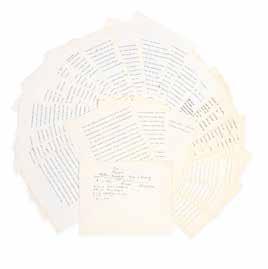
Enquiries: Kieran O’Boyle +353 1602 0990 kieran.oboyle@bonhams.com
Artist
An important early work by Bhupen


Bonhams Magazine | 13
Show me the mummy
NEWS
A rare Egyptian painted wood decorated coffin for the lady Irtwrw, dating to c.747-525 BC, achieved an impressive £406,800 at the July Antiquities sale in London.
in residence
Khakhar, Residency Bungalow, led the Modern & Contemporary South Asian Art in London in June, achieving £1,984,400.
O O
Delon in dreamland La baie de Sainte-Adresse by Raoul Dufy (1877-1953) sold for €1,016,400 at the ‘Alain Delon: 60 Years of Passion’ sale in Paris in June.
O
Surrealism: Beyond Reality
New York
Wednesday 15 November 3pm
Leonor Fini (1907-1996)
Sphinx Ariane (detail)
gouache and oil on paper laid on canvas 28¼ x 22½in (72 x 57cm)
Painted in 1973
Estimate: $100,000 - 150,000 (£80,000 - 120,000)
Enquiries: Emily Wilson
+1 917 206 1627
emily.wilson@bonhams.com

Trading places
For May Matthews, the Managing Director of Bonhams Scotland, it all began with a shove ha’penny board. She was only ten-years old when her family took her to an auction somewhere in the Lake District. She was the only child bidding in the saleroom, but £12 clinched her coveted Victorian game, winning against a grown-up dealer. Since that moment, she has been hooked on the thrill of the sale.

Many triumphs would follow. Just a couple of years into her Bonhams career, she sold one of the earliest known depictions of a football game, by Alexander Carse, for more than £266,000. Then, as Head of Scottish Pictures (a position she still holds), she raised more than £300,000 through the sale of two exceptional works by the Scottish Colourist S.J. Peploe – which was all the sweeter given that the procceds of the sale were going to Amnesty International.

More recently, May’s skills were needed outside the saleroom. She was in charge of Bonhams Scotland’s move to its new headquarters at Melville Crescent, in Edinburgh’s fashionable West End. She celebrated the opening with the ‘Best of Bonhams’ exhibition, whose displays demonstrated the exceptional depth and breadth of Bonhams’ international network, spanning a Renoir painting and a dinner suit worn by (almost) everyone’s
favourite Bond: Sir Roger Moore. “It was an opportunity for the public to wander in and be inspired by amazing objects, especially those who don’t normally view our fine art sales,” explains May.
The inviting openness of the Melville Crescent building – a bright and luxurious Georgian townhouse, with many original features – was one of the selling points for May and her colleagues. There were two large salerooms at the former Edinburgh headquarters on Queen Street, but the space was mostly panelled off from the public. At Melville Crescent, however, everyone is welcome to come in and browse the exhibition gallery, even if no auctions are taking place.
Still, closing the doors on Queen Street in July was bittersweet. After all, it had been there that Bonhams Scotland set the world record price for a bottle of whisky in 2018. “That was incredibly exciting,” May says. “To see a Scottish product achieve such a price in a Scottish saleroom.” Other memorable lots to go under the hammer there included a print of King Charles III’s painting of Balmoral. And, on a personal level, the building had witnessed many of May’s earlier career highlights, through

Bonhams Magazine | 15 INSIDE BONHAMS
With Bonhams Scotland safely moved to new headquarters, May Matthews tells Hongmiao Shi about her lifelong love of auctions
Above Melville Crescent in Edinburgh’s fashionable West End, the new Bonhams Scotland headquarters
Right May Matthews, Managing Director of Bonhams Scotland, holding Still Life with Dahlias by George Leslie Hunter (18771931), estimated at £50,00070,000 at the Scottish Art Sale on 11 October
the sale of works of art that she adored and had put her “heart and soul” into researching and cataloguing ahead of each auction.
This love of history, and her desire to dig deeper into the past, have been constant pillars of May’s life. Born in Sussex, her father was a fisherman and her mother a primary school teacher. Both were enthusiastic Morris dancers. This meant that, when May was a child, every weekend her family would be going somewhere different – a castle, an open-air museum, a car rally – to dance. May and her sister performed with the children’s group, the Morris Minors (folk dancers, like drinkers of craft beer, do love a play on words – and clearly classic British cars as well). She was even once the May Queen: “You can imagine the headlines in the local papers? May, being May Queen…”.
May’s connection with Scotland has been another theme of her life. Her mother’s side of the family are from Aberdeen, and May would spend most of her summers there. Feeling “very at home in Scotland”, she studied archaeology at Edinburgh University. And it was while she was on a dig in Cyprus that she met another student who was already working part-time for Bonhams. “She told me it was a friendly, interesting place, and that they were always looking for part-time staff.”
A few months after joining the viewing staff team at Bonhams, May had worked her way up from receptionist to specialist in the Scottish Art team and later heading up the department. In 2022, she took on the role of Managing Director.
What does she have planned for Bonhams Scotland? First, there’s an exciting programme of auctions, with the number of sales in Edinburgh for 2023 already doubled in comparison to last year. The first live auction
at Melville Crescent – the Scottish & Celtic Sale – takes place in September, followed by the biannual Scottish Art sale in October (Bonhams is currently the only international auction house to sell Scottish art in Scotland). May has already consigned paintings by the Scottish Colourists and works by Mary ‘May’ Reid, an artist who attended the famous Glasgow School of Art in the early 20th century and became part of the cultural elite. Later this year, there will be a themed auction dedicated to dogs, which will run from paintings to the decorative arts.
Beyond the auctions, May is strengthening the connection between the Edinburgh valuations team –the biggest outside London for any auction house – with the rest of the Bonhams network. “When we foster these links with our global teams across the world,” she explains, “we can really maximise what we already do very well.” To give just one recent example of how successful this collaborative relationship can be, last year May’s team received a still-life painting that the seller purchased on eBay for £40, which turned out to be a work by early 20thcentury Finnish artist Helene Schjerfbeck. Her colleague had it shipped to Bukowskis (Bonhams’ sister auctionhouse in Stockholm) within 48 hours. It made it into the auction, where it sold for the equivalent of £99,000.
Hongmiao Shi is Content Editor of Bonhams.com.
Top left
Samuel John Peploe, RSA (1871-1935)
Flowers and Fruit 1920 oil on canvas

Sold at Bonhams for £510,000
Top right
Helene Schjerfbeck (1862-1946)

White roses in a glass
Sold at Bukowskis for £99,000
Left Joan Eardley RSA (British, 1921-1963)

Two Girls (1962)
pastel on glasspaper
Sold at Bonhams for £47,000
| Bonhams Magazine 16 INSIDE BONHAMS
A Focus on William Kentridge
London
Wednesday 27 September 3pm
William Kentridge (b.1955)
Casspirs Full of Love (Study III), 1988-1989

Encaustic on paper
188 x 107cm (74 x 42⅛in)
Estimate: £200,000 - 300,000
($260,000 - 380,000)
Enquiries: Helene Love-Allotey
+44 (0) 20 7468 8213
helene.love-allotey@bonhams.com
Opposite Henry Moore O.M,
Head, 1930 ironstone on a marble base 17.7cm (7in) high, including marble base
Estimate: £2,200,000 - 2,600,000 ($2,900,000 - 3,400,000)
A head of the curve
The miner’s son is recognised once more as Britain’s greatest modern sculptor. There’s Moore than meets the eye, writes Mark Hudson
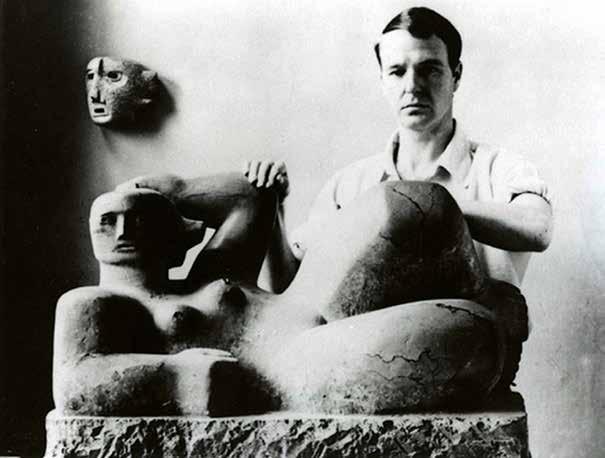
Henry Moore is, on the face of it, an unlikely contender for the role of the most controversial British artist of the 20th century. A patently decent man, who did more than anyone to establish British modern art as a force on the international scene, the Yorkshireborn sculptor left most of his large fortune to a foundation supporting new art. Yet the sheer scale of Moore’s fame caused a sense of resentment and rebellion among younger artists. In the post-war period, he was promoted by the state as the embodiment of an outward-looking Britain. By the 1970s, there were no fewer than 40 Henry Moore exhibitions taking place around the world at any one time.
Following Moore’s death in 1986, there was a slump in the artist’s critical and popular esteem, with his position as “the greatest British artist of the 20th century” usurped by the once-marginal Francis Bacon. The doughty Moore, with his strong, affirmative, semi-abstract forms, seemed the epitome of the uncool.
Today, however, nearly 40 years on, that position is close to being reversed. Bacon’s nihilism and emotional violence are so well established they feel almost predictable, whereas Moore’s aesthetic value, cultural meaning and significance feel more open to debate than they’ve ever been.
Tate’s major 2010 Moore exhibition sought to reveal an edgy artist far removed from the avuncular, establishment-friendly figure of popular myth, informed by new ideas about sex and psychoanalysis and the turbulent political climate of the interwar period. While the show didn’t include the monumental late sculptures, these works were the subject of a 2012 exhibition at Gagosian in London that drew an excited response, particularly from younger artists.
This November, Bonhams is offering a relatively small work from 1930, an exquisitely sensitive female head in profile, only seven inches high, its slender form carved from one of Moore’s favourite materials of this period: ironstone.
If it might seem absurd to describe a sculpture as ‘in profile’, Moore, with his passion for direct carving –working with the physical peculiarities of his materials – has followed the contours of a flat pebble, picked up on a Norfolk beach, so that the profile is seen at full
| Bonhams Magazine 18
“Moore, with his passion for direct carving has followed the contours of a flat pebble”
Left Henry Moore with Reclining Figure (1929) and Mask (1930)
C.H. (1898-1986)
© Henry Moore Archive, courtesy of Leeds Museums and Galleries
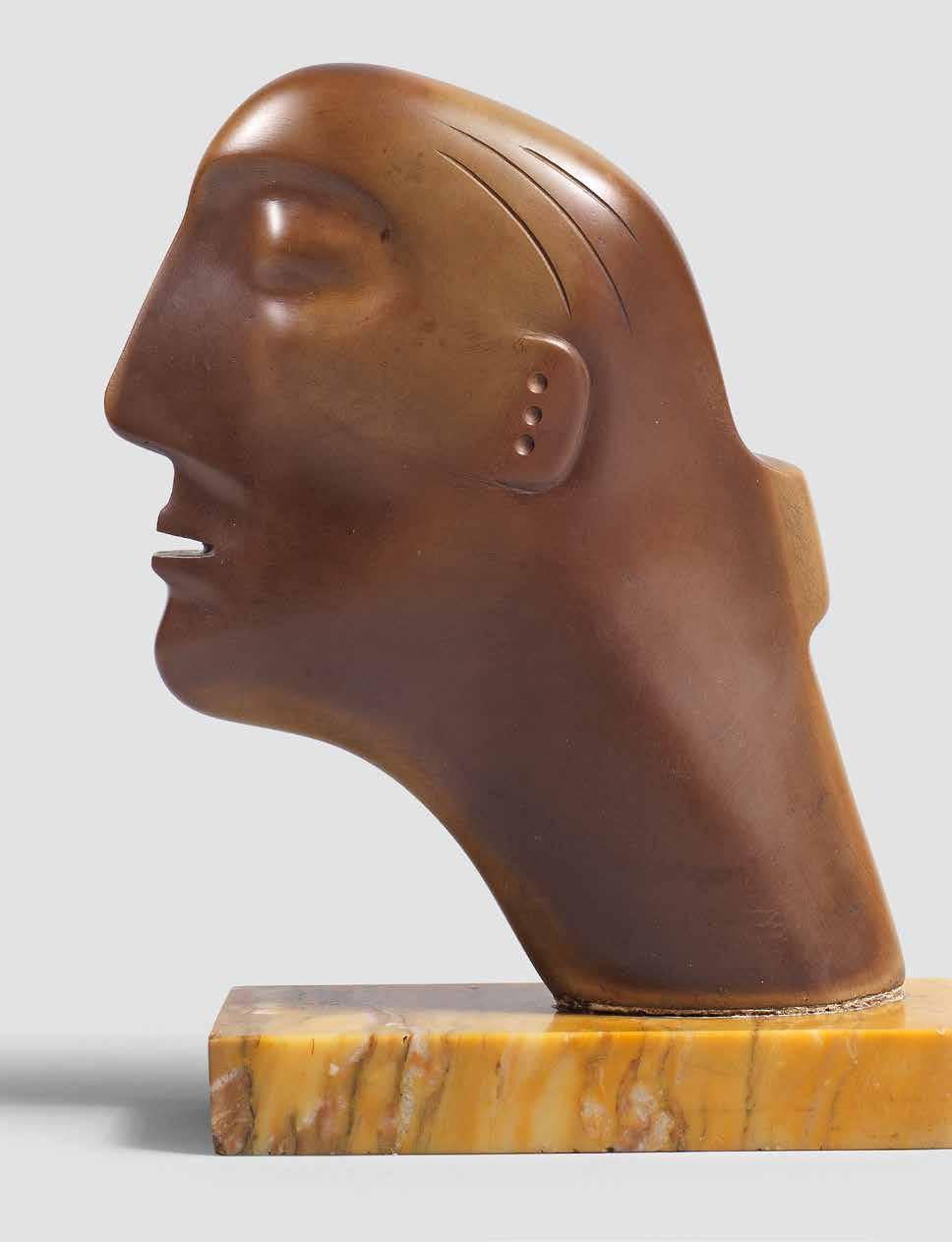
Right
breadth while the features narrow abruptly towards the edge. It’s a work that exemplifies Moore’s ability to surprise – and the complex network of influences he was negotiating at a pivotal crossroads in his career: between the monumental sculptures of the 1920s and the more abstracted forms he produced in the period immediately before the Second World War.
Henry Moore was born in Castleford in West Yorkshire in 1898, the seventh son of a coal miner. His father, who believed in education, had risen to the position of ‘pit deputy’, a minor official at Wheldale colliery, which loomed over the community.

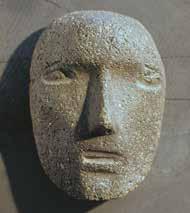

Moore grew up intensely aware of the rolling contours of the Yorkshire Dales, and decided to become a sculptor at the age of 11 after hearing about Michelangelo’s achievements in a Sunday School class. All of that confirms the mythic sense of Moore as an artist conflating human and landscape forms, and rooted in a confluence of Victorian-style self-improvement, strong moral values and gut-level socialist principles that he hung on to even in the face of global fame and immense wealth. Indeed, on my first visit to the Henry Moore Studios and Gardens at Perry Green in Hertfordshire, I was struck forcefully not by the carefully preserved workspaces or the surrounding fields dotted with enormous sculptures, but the sheer ordinariness of the farmhouse where Moore lived, with its battered armchairs and humdrum kitchen unchanged, since the 1950s. That environment again might seem to conform to Moore’s image as an artist of bluff, uncomplicated physicality. Yet there’s no law that says that a fondness for simple living and a profound identification with
one’s formative landscape should militate against a sense of deep moral ambiguity and personal unease.
While Moore’s childhood was, by his own account, “blissfully happy and secure”, his best work emerged, according to his friend and patron, the National Gallery director and broadcaster Kenneth Clark, from a “deep, disturbing well” of troubled thoughts and feelings. Yet this emotional netherworld was, according to Clark, “never referred to, and no one meeting him could have guessed at its existence”.
Moore was undoubtedly traumatised by the experience of being gassed while serving on the Western Front during the First World War. In 1925, he came his closest to a nervous breakdown on a study visit to Florence, overwhelmed by the sheer volume of new experiences and the fact that his best friend’s fiancée – with whom he was in love – did not share his feelings. Yet Moore wasn’t one to allow even the most painful experiences to obstruct his professional development.
By the early 1920s, by which time he had won a scholarship to London’s Royal College of Art, he was breaking free of the Victorian romantic tradition in which he had started out, absorbing the art of a wide range of cultures in the British Museum: Ancient Egyptian, African, Oceanic and, particularly, Meso-American.

| Bonhams Magazine 20
Above & above right Moore worked in more than 40 different types of stone over the course of his career
The chacmool from Chichén Itzá
“The features appear immersed in some semiconscious state, sleep or sensual rapture”
The massively weighty but dynamic form of Toltec Maya sculpture known as a chacmool – a reclining figure – fused with the rhythmic flow he had observed in the Parthenon Marbles gave rise to powerful monumental sculptures invariably featuring strong female figures, with mother and child a recurring motif.
Moore’s mother was his most important early influence, with his art teacher from secondary school, Alice Gostick, to whom he was extremely attached, taking on a similar role. “I suppose I have a mother complex,” he admitted to an interviewer late in life. Moore’s only real relationship was with Irina Radetzky, a Royal College of Art student of Russian aristocratic origin, whom he married in 1929. By this time, his work was taking a different turn, having come under the influence of Surrealism and widely disseminated ideas about the unconscious stemming from the then popular interest in psychoanalysis.
The image of woman in the delicate form of Head(1930) appears more vulnerable and fugitive than in the robust forms of the previous decade. The features appear immersed in some semiconscious state, sleep or sensual rapture, the lips parted, eyes reduced to formalised bulges in the highly polished stone.
The streamlined, forward-leaning form bears a faint touch of Art Deco and of modernist sculptors who presaged that style, such as Brancusi and Modigliani. Yet, where their forms tend towards rigid symmetry, Moore’s have a marvellously supple irregularity as he yields to the form of the brown ironstone.
Named for its rust-like colour rather than its durability, ironstone is easy to work and polishes to
Left Henry Moore O.M, C.H. (1898-1986)
Head, 1930 ironstone on a marble base 17.7cm (7in) high Estimate: £2,200,000 - 2,600,000 ($2,900,000 - 3,400,000)

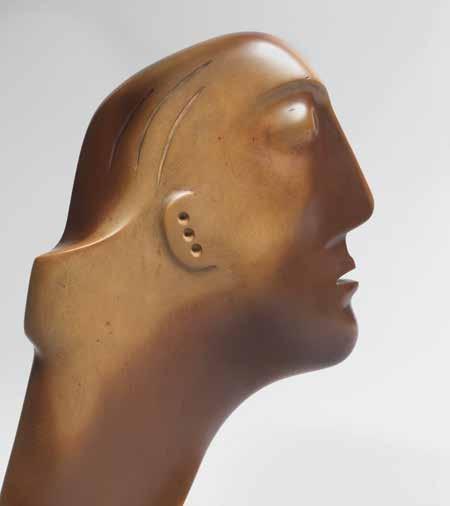
Above Henry Moore’s Mask of 1929, which sold at Bonhams in 2018 for £3,250,000
the sheen of a multi-hued bronze. In the early 1930s, Moore was having crates of the stone carried back to London, as he allowed the structures of nature to actively dictate some of his most uncompromising interpretations of human form.
He managed to pack an extraordinary amount of resonance into this small work: suggestions of abstracted classicism that feel filtered via Picasso, but most of all the sense found in the African and Oceanic art he loved – the Easter Island statues come to mind – of the human form immured in forms of instinctive knowledge that go far beyond the merely human.
Headfeatured in Moore’s second solo exhibition at London’s Leicester Gallery in 1931, which featured an enthusiastic catalogue introduction from the leading modernist sculptor of the previous generation, Jacob Epstein. While the show initially attracted hostile reviews, Moore was soon acclaimed on London’s emergent Modernist art scene – hailed as a genius at the age of only 33. To the vast majority of the British population, of course – or those that were even aware of it – Moore’s art remained the object of incomprehension and derision. But that is exactly what we’d expect of a truly challenging artist, at the start of an unstoppable ascent experienced by few artists of any period.
Mark Hudson is Chief Art Critic of The Independent
Sale: Modern British Art London
Tuesday 22 November at 3pm
Enquiries: Penny Day +44 (0) 20 7468 8366 penny.day@bonhams.com
Bonhams Magazine | 21
Main image
Robert Colescott (1925-2009)
1919, 1980
acrylic on canvas
71¾ x 83⅞in (182.3 x 213.2cm)
Estimate: $3,000,000 - 5,000,000
(£2,500,00 - 4,000,000)
Life in colour
Only when he came to Egypt did Robert Colescott find the inspiration for the vivid, satirical paintings that made his name, says Matthew Weseley

There’s a much larger and more complicated story behind the art of American painter Robert Colescott (1925-2009) than most realise. And an important part of it is told by the painting called 1919that he created in 1980 – which will be offered by Bonhams as a single-lot sale in New York this September. Colescott was the second of two sons born to Warrington Wickham Colescott Sr and Lydia Kenner Hutton, who emigrated from New Orleans, Louisiana, to Oakland, California, in 1919. Colescott described this relocation as part of the Great Migration of Black Americans from the segregated South into less racially restrictive parts of the country. There’s considerable
evidence that his parents – whose appearance made it possible for them to pass for white – intended to take advantage of the more relaxed atmosphere in California in order to assimilate into the mainstream. They settled in a white neighbourhood and their two sons attended schools where the overwhelming majority of students were white.
There were setbacks. Although Colescott’s father had hoped to work as a professional musician, he remained an employee of the Southern Pacific Railroad. Because his older brother Warrington appeared to be white, Robert Colescott’s mother perhaps preferred his older sibling to her younger son, whose skin colour and facial features alluded to their African ancestry.
Nonetheless, Colescott succeeded in passing in
| Bonhams Magazine 22
“His parents intended to take advantage of the more relaxed atmosphere in California”

the white world. He volunteered in the US Army during World War II, serving in a regular unit – rather than one consisting of Black or ‘colored’ troops – at a time when the Army was still segregated. After the war, Colescott attended college to study art. Having graduated from the University of California, Berkeley, he travelled to Paris, where he attended the atelier of Fernand Léger. Between 1952 and ’64, Colescott worked as an art teacher in the Pacific Northwest. He lived in predominantly white neighbourhoods, employed by institutions where the overwhelming majority were white.
While living and working there, Colescott’s racial identity was interpreted differently by different people. It never occurred to a white, female student who worked with him for an entire year that he was Black. A Black student in one of Colescott’s classes was excited to have as a teacher someone with whom he could identify racially, but he was disappointed when Colescott seemed to give him the cold shoulder. Arlene Schnitzer – whose gallery Colescott joined in 1961 – asked him directly about his background, and he did not identify himself as Black. This must have been an uncomfortable situation for Colescott – to say the least.
It is unclear why Colescott decided to apply for a grant to spend a sabbatical year in Egypt. In interviews later in life, he gave the impression that he went on a whim. It is possible that Colescott’s acrimonious divorce in 1961 from his first wife – a Czechoslovakian woman whom he had met in Paris – followed not long after by his marriage to his second wife, created a scandal in Portland which he wished to escape. The fact that his application was accepted reflected the support that he had earned from the powers-that-be in the

Portland art world at the time
In later years, Colescott recalled his sojourn in Egypt as the first time he felt truly at home. “Walking down the street in Cairo was to be walking among people like myself,” he recalled. “Everybody – the president of the country and on down – was a person of color.” Until this point, he had followed the guidance of his parents –particularly his mother – in choosing to identify publicly as white. In Egypt, he began to have second thoughts. His mother’s death in 1966 might have also provoked soul-searching. His experience in Egypt was emotional and cathartic. He was also impressed with ancient Egyptian art. As well as the grandeur of the ruins, the narrative element of Ancient Egyptian art captured his attention. His second year in Cairo was cut short by the outbreak of the Six Day War, so he, his wife, and their son spent the remaining years of the decade in Paris. Although they did not divorce until 1971, Colescott and his second wife went their separate ways, and he returned to the San Francisco Bay Area in 1970. The country he found on his return was not the same as the one that he had left.
Between 1970 and ’74, Colescott taught at Stanislaus State College in Turlock – a small, somewhat remote town. In the studio, his thoughts turned to his formative years. The effects of the social and political turmoil of the 1960s were still being felt, and the assertiveness of those challenging established hierarchies inspired him. “My experience had been that you came back from Europe and the only Black people you would see in airports were people pushing a broom,” he recalled. “Now they were demanding more, and that affected my painting. I felt like I had a lot of things to say.”
Colescott’s paintings of the 1970s were a delayed

| Bonhams Magazine 24
Right Robert Colescott’s parents, Warrington and Lydia
Far right Colescott’s satirical 1980 painting Miss Liberty, sold by Bonhams in February 2023 for $4,500,375
Above Robert Colescott, photographed shortly after his return to the United States from Egypt
Below Robert Colescott’s George Washington Carver Crossing the Delaware River: Page from an American History Textbook, 1975, Lucas Museum of Narrative Art, Los Angeles
Courtesy of the Colescott family
© 2021
The Robert H. Colescott Separate Property Trust/Artists Rights Society (ARS), New York
response to his socialisation, including the derogatory images of black people that used to flood the mass media prior to World War II, as well as the lack of meaningful acknowledgment in his school textbooks of the contributions that had been made by people of African descent to American history.

The series of paintings that Colescott began in 1970 established his reputation. They are very personal. Their purpose was to exorcise the racism that he internalised from his mother and the world in which he grew up. In these paintings, he employed minstrel images – racist stereotypes that date to the 19th century – in order to demonstrate the preposterousness of generalisations concerning people of African descent. A minstrel image is a white person in blackface, his or her face darkened in order to ridicule and degrade Black people. In 1975, Colescott created his most widely reproduced work, GeorgeWashingtonCarverCrossingtheDelaware:
PagefromanAmericanHistoryTextbook. It’s a version of Emanuel Leutze’s famous painting of 1851, except Colescott has replaced George Washington and his retinue with the prominent agricultural scientist George Washington Carver and a coterie of stereotypical images of Black people. The painting points to the exclusion of people of African descent from dominant historical narratives and mainstream American society.
While the paintings of the 1970s constituted a public acknowledgment of the artist’s Black identity, they also call into question the system of racial classification that bedevilled his life. In an application for a Guggenheim Foundation grant in 1972, he described the “absurdity of racial definitions” as a theme of his recent works. In an interview in 1988, he elaborated this further. “When we try to lump people into one category, whether it is the way they look or whatever it happens to be, this is a silly thing,” he explained. “When you inject silliness into the context of a work of fine art, especially a monumental work, people fall back on their heels.” Colescott’s paintings of the 1970s are as complex and double-edged as the man himself.
In 1980, Colescott cast a final backward glance before moving on to less personal subject matter. In 1919 , he commemorated his parents’ migration from Louisiana
to California six years before his birth. Bust-length portrayals of his parents – imbued with the impassiveness of statuary – face each other from either side of the canvas. They float among pink clouds that symbolise their existence within the ephemeral realm of art. They are posed before a graphic map of a type popular before World War II, in which local cultures are represented by cartoon vignettes. At the centre of the canvas, Colescott’s family is represented by a bird’s nest with two chicks tended to by their parents. Among the clouds are attributes pertaining to both parents. His mother’s light skin symbolises her effort to impose whiteness on him, while his father’s dark skin symbolises his love for and acceptance of his darker-skinned son. In reality, Colescott inherited from his mother the physical attributes that so displeased her. Apparently, she persecuted him for qualities that she might have disliked in herself.
1919 is unique in Colescott’s oeuvre. His paintings of the 1970s visualise satirically the social forces that shaped him, and in 1919 he included likenesses of the two individuals who most influenced him. In travelling from New Orleans to Oakland in 1919 – in the hope of reinventing themselves and improving their situation –Colescott’s parents set in motion a chain of events that led their son to the turning point in Egypt and the outrageous and provocative paintings that are masterpieces.
Matthew Weseley is the co-author of Art and Race Matters: The Career of Robert Colescott
Sale: Robert Colescott New York
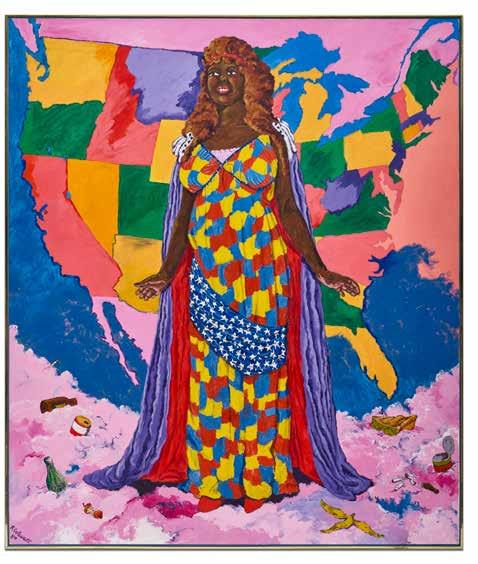
Friday 8 September
Enquiries: Randy Reynolds +1 212 644 9089 randy.reynolds@bonhams.com
Bonhams Magazine | 25
“Colescott recalled his sojourn in Egypt as the first time he felt truly at home”
Courtesy of Lauren McIntosh Walrod
©
NEW YORK
The Robert H. Colescott Separate Property Trust / Artists Rights Society (ARS), New York.
Metal guru
Pablo Picasso was one of many artists who recognised the genius of goldsmith François Hugo. Kate Youde talks to Nicolas Hugo about his grandfather
The artist Jacqueline Roque tried all her “powers of persuasion” to have her lover, Pablo Picasso, exhibit his silver dishes in Marseilles in 1959. “But Pablo has other ideas and since they are bound to be excellent – let us wait,” she wrote in a letter to the goldsmith François Hugo.
It would be eight years until the public got to see some of Picasso’s designs in silver. An exhibition at Galerie le Point Cardinal in Paris in November 1967 showcased François’s collaborations with artists at his workshop in the south of France on wearable sculpture and limited edition objects in silver and gold.
A plate from each of the 24 silver editions on which Picasso and François collaborated are among the hundred lots being offered at Bonhams by Ateliers Hugo from their work with famous artists; some of them have never been seen before. The sale is timed to coincide with this year’s 50th and 60th anniversaries of the deaths of Picasso and Jean Cocteau, respectively, and the 90th anniversary of the start of François’s career as a goldsmith.

Born in 1899, François’s early work in metal led him to create bespoke buttons for haute couture dresses by fashion designers including Elsa Schiaparelli. His first
Vallauris silver plate, 1956
Estimate: €25,000 - 30,000 (£20,000 - 25,000)
Above
At the goldface: in the workshop of Ateliers Hugo

Opposite “What can you make of this?”
Picasso shows a drawing to François Hugo
collaboration with an artist was with the sculptor Alberto Giacometti on buttons for Schiaparelli, says François’s grandson Nicolas Hugo, director of Ateliers Hugo today. However, it is François’s collaboration with Picasso that put the goldsmith on the map.
In 1956, Picasso was already working with the Madoura pottery in Vallauris, south-east France, when he decided
he wanted to do something in silver. His friend, the art historian Douglas Cooper suggested he should contact François. The pair had met before, at the premiere of the Ballets Russes production of Paradein Paris in 1917, for which Picasso designed the sets and costumes. French polymath Cocteau, a complete set of whose designs with Ateliers Hugo is being offered in the auction, contributed the story.
| Bonhams Magazine 26
“It is François Hugo’s collaboration with Picasso that put the goldsmith on the map”
Left Pablo Picasso (1881-1973)
Image courtsey of Atelier Hugo
 Image courtsey of Atelier Hugo
Image courtsey of Atelier Hugo
The first piece François worked on with Picasso was a plate based on the Spaniard’s LeDormeurceramic platter. It was a challenge, says Nicolas, although his “genius” grandfather was up to the task, inventing his own tools for the job. He used the repoussé-ciselé technique still used by Ateliers Hugo today, placing a sheet of silver on a bronze mould and hammering it from the back. “What you hammer from the back comes out in the front,” says Nicolas, adding that a plate typically requires 20,000 hits, after which it is polished.

Picasso was so “enchanted by the result”, says Nicolas, that he ordered more plates of different designs. “But he didn’t want to commercialise them,” he says. “He kept them under his bed, hidden like a treasure.”

François, who died in 1981, moved in artistic circles. His brother Jean and Jean’s first wife, Valentine Hugo, were painters. Dada and Surrealist pioneer Max Ernst was a great friend. The Fauvist André Derain was best man for François’s second marriage, to Monique, whom he had met in Cannes during World War II. The friends experimented together on pieces at Derain’s studio in Chambourcy, says Nicolas, without much success: they set fire to the workshop. However, Derain gave François some lead sculptures before his death in 1954, from which François later made editions of gold medallions. Nicolas says the heavy, “primitive” designs “don’t look as sophisticated” as some of those by other artists, but have a “more masculine effect” that matched Derain’s persona.
François and Monique bought a house in Aix-enProvence in 1954, making the move permanent four years later. François set up his workshop just metres from the kitchen, where Ateliers Hugo remains today. Here he worked on further designs for Picasso, inspired, Nicolas says, by Roque’s desire to wear his work around her neck.
However, it was only in 1967 that Picasso granted François permission to make the first limited edition of his designs. In the years since Picasso had started working with Ateliers Hugo, François had collaborated
on artist jewels with friends including Ernst, the sculptor and painter Jean Arp, and the painter Dorothea Tanning (Ernst’s wife) – the only woman with whom Ateliers Hugo has collaborated to date. Tanning’s designs in the sale include a gold octopus brooch and a gold bracelet inspired by her dog Groutcho. “She was very smart, very funny,” says Nicolas, who remembers her visiting their house.
The exhibition was the first public display of the work of Ateliers Hugo. “Then it kicked off,” says Nicolas.
François’s son Pierre, father of Nicholas, joined him in the workshop in the early 1970s, taking over in 1977. He oversaw the business’ expansion, selling pieces to international collectors and participating in gallery

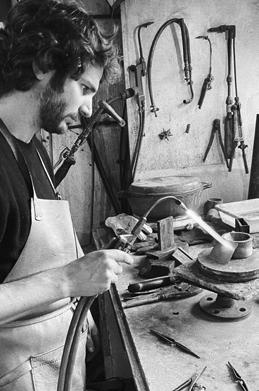
| Bonhams Magazine 28
Above Jean Cocteau (1889-1963)
Visage en V gold earrings
Estimate: €600 - 800 (£500 - 700)
Right Pablo Picasso (1881-1973)
Faune gold medallion
Estimate: €12,000 - 18,000 (£10,000 - 15,000)
Left Nicolas Hugo following in his grandfather’s footsteps at Ateliers Hugo
“Picasso ‘kept them under his bed, hidden like a treasure’”
Nicolas Hugo Credit Ateliers HugoMaxime Souyri
a curse” and wanting to make his own way. However, he didn’t want the business to be lost. “Only a Hugo can take over this,” he says. “It’s the brand.”
Picasso would mock François about the Hugo name, and gave him a drawing, dated 13 February 1971, addressed to ‘Mon Ami Victor’. François used this as inspiration for an edition of gold ear-rings produced after Picasso’s death, presented in the sale. Ateliers Hugo only works with artists the family has met and on designs produced during an artist’s lifetime. Once an edition is finished, they do not reissue designs.
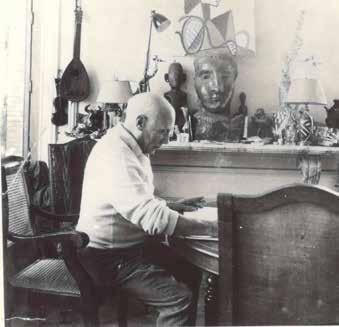
The auction features one of an edition of 20 from each of the 24 gold medallion designs Picasso made with Ateliers Hugo based on his ceramic plates, as well as other designs. One of Nicolas’ favourites is the Grandfaune gold medallion, the original drawing for which hangs in his Paris apartment. “It reminds me of me, this guy,” he says about the “cheeky”, smiling face.
Nicolas spends one or two days a week in the
Above right Max Ernst (1891-1976)
Grand ovale Gold medallion
Estimate: €10,000 - 15,000 (£8,500 - 12,500)
workshop in Aix-en-Provence, while his father Pierre still visits every day and hallmarks the creations. They are joined in the business by four craftspeople: atelier head Bernard Baur, who has been with Ateliers Hugo 35 years, Baur’s two nephews, and Nicolas’s best friend.
Little has changed over the decades, including the smell of the workshop – a mix of the gas used for welding, nicotine, leather and wood – and the production method. “It’s our technique and the artists come for this,” says Nicolas. “Like sometimes at auction you have a still-wet painting – this is a slow way of thinking. A collaboration takes two years to make between three and six jewels.”
While recognition of artist jewels has grown in the past decade, thanks in part to galleries specialising in the genre, Nicolas hopes that the auction, like the pivotal exhibition in 1967, puts the work of Ateliers Hugo in the spotlight. “When you see one jewel, it’s impressive,” he says, “but when you see the whole thing there’s something mystical about it.”
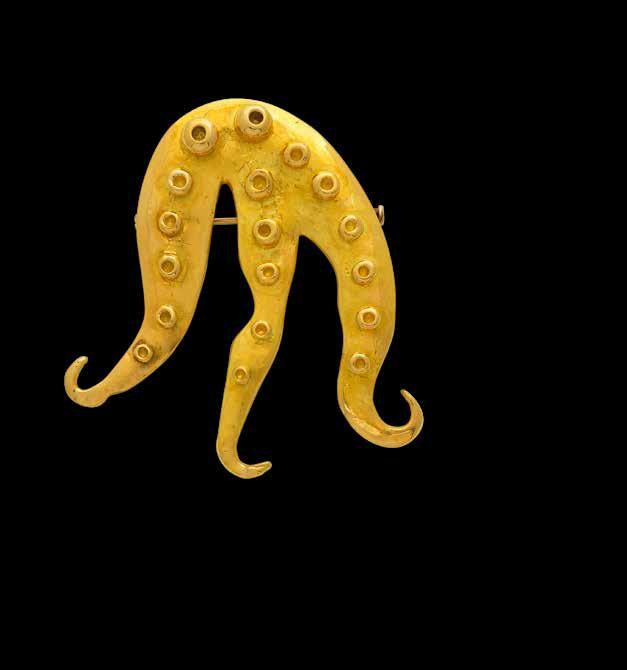

Kate Youde writes for the Financial Times and other publications.
The exhibition Picasso – Ateliers Hugo: Les Hommes d’Or is at Musée Magnelli in Vallauris until 25 September.
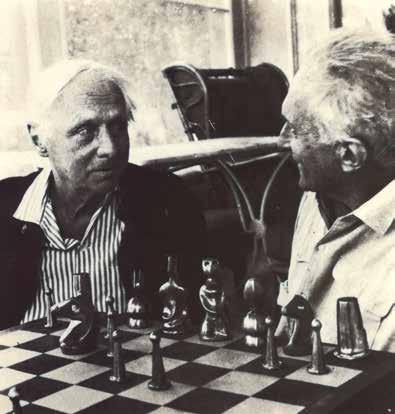
Sale: Ateliers Hugo
Bonhams Cornette de Saint Cyr, Paris
Thursday 28 September
Enquiries: Emilie Millon +33 1 42 61 10 10 emilie.millon@bonhams.com
Bonhams Magazine | 29 PARIS
Max Ernst (on the left) playing chess with François Hugo
Nicolas Hugo Credit Ateliers Hugo
Nicolas Hugo Credit Ateliers Hugo
EON Productions
76cm x 104cm (30in x 40in)
Estimate: £800 - 1,200
(£1,000 - 1,500
Below Omega ‘50 Years of 007’ limited edition automatic calendar bracelet watch
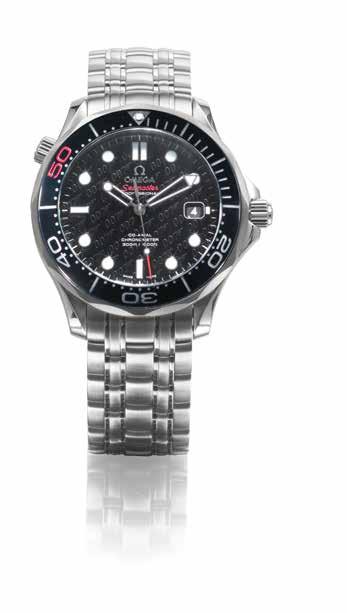

James Bond 50th Anniversary circa 2012
Estimate: £20,000 - 30,000
(£25,000 - 40,000)
The eyebrows have it
As suave and gentlemanly off the screen as he was on it, Sir Roger Moore brought a light touch and good humour to every role, especially James Bond, says Ryan Gilbey
For anyone who grew up in the 1970s and 1980s, Sir Roger Moore was the ultimate James Bond: wry without undermining the suspense of the films, debonair but never distant, he seemed to relish his adventures every bit as much as the audience did. No other performer in the part was able to mix style and suavity with the dash of silliness Moore brought to the role. And some of the dottiest onscreen touches – such as the unforgettable moment in TheSpyWhoLovedMe (1977) when Bond lowers the window of his sleek white Lotus Esprit following an underwater drive and deposits a small fish which has somehow found its way inside the vehicle – were his idea. As was the choice to bring a certain warmth to the role after the remorselessness of Sean Connery. Moore was clear on the distinction between their interpretations: “Sean played Bond as a killer and I played Bond as a lover,” he said.

Not that he couldn’t be beastly when the need arose. But there was an essentially gentlemanly quality to Moore’s version of Bond. Humility and self-deprecation always played a large part in the actor’s appeal. Whenever anyone cracked a joke
regarding his range or ability, chances were that Moore had got there first. Take the 1980s satirical TV puppet comedy SpittingImage, which represented Moore as an immobile face with a pair of sporadically twitching eyebrows. What most viewers didn’t realise was that the gag originated with him. “The eyebrows thing
was my own fault,” he said. “I was talking about how talentless I was and said I have three expressions: eyebrow up, eyebrow down and both of them at the same time. And they used it – very well, I must say.”
Humour suffused his interpretation of Bond, whom he saw as an essentially comic character. After all, he reasoned, a man who can walk into any joint in the world only to find that the bartender already knows his favourite drink can’t be much cop as a secret agent.
| Bonhams Magazine 30
“I have three expressions: eyebrow up, eyebrow down and both of them at the same time”
Right Moonraker James Bond film poster, 1979

but
distant” - it must be
Roger Moore
Roger Moore.
of Eon Productions and Metro Goldwyn Mayer Studios. THE SPY WHO LOVED ME © 1977 Danjaq, LLC and Metro-Goldwyn-Mayer Studios Inc.and related
Bond Trademarks, TM Danjaq. All Rights Reserved.
“Debonair
never
Moore,
Sir
Courtesy
James
One thing he took seriously, however, were his clothes, as shown by many of the items in Bonhams’ October sale ‘Sir Roger Moore: The Personal Collection’, which coincides with the 50th anniversary of the actor’s 1973 debut as Bond in Live and Let Die Featured in the collection is an array of dapper silk ties and cravats, as well as numerous suits and sunglasses. Several items will leap out for Bond enthusiasts. There is a mohair single-button dinner Octopussy (1983), as well as two items from his final Bond film, A View to a Kill, from 1985: a white ski suit with fur-lined hood, jacket and trousers with pink tartan lining, and a mohair double-breasted dinner suit that he wore while clambering up the Eiffel Tower in pursuit of the singer Grace Jones, who played the assassin May Day. (She got away on that occasion, though the pair later shared a bed scene.)

ForYourEyesOnly (1981), which signalled a back-to-basics approach after the costly Star Wars-

influenced space-age shenanigans of Moonraker two years earlier, there is the grey flannel three-piece suit that Bond wears in the pre-credits sequence, when he is almost outfoxed by a bald, wheelchair-bound villain, who was a dead ringer for his old arch-enemy Blofeld (though unable to be identified as such at the time due to a copyright dispute over the character). Also in keeping with his on-screen persona are the multiple sets of skis, including two pairs made specially for the actor by Lamborghini: for his feet only, you might say. Moore got his start as a film extra and stage performer, and even worked as a model for knitwear patterns and photo stories in teen magazines. In other words, he already had an idea of how to

“Skis were made specially for the actor by Lamborghini: for his feet only, you might say”
I first saw Roger Moore on screen when he played a tennis champion flirting with a married Elizabeth Taylor | in the film version of F. Scott Fitzgerald’s haunting short story ‘Babylon Revisited’. (The movie’s title was The Last Time I Saw Paris.) This was back in the mid 1950s, and I was about to go on the tennis circuit. Roger’s stylish role made a great impression. I remember thinking that if all tennis players were like Roger, the fun was just beginning.
Well, of the hundreds of players on the circuit back then, perhaps two – the American Budge Patty and the Belgian Philippe Washer – came close to resembling the elegance and urbanity of Roger Moore, but not really. Fifteen years later, in Gstaad, I met the real McCoy, and it was the start of a beautiful friendship, as they used to say in Casablanca
The problem with writing about Sir Roger is very simple: today’s public relations hacks have made superlatives the norm, with the dismaying reality being that every public person today is described in glowing terms that even Hollywood boosters cannot match. So I will confine myself in describing Roger as truly stylish, style being the most overused word in the English language. True style, however, is an elusive quality, and few fashionable people possess it outright. No one is capable of buying it, and it is of an abstract nature. One either has it or doesn’t. Today, more than ever
Opposite, top left
The Spy Who Loved Me James Bond film poster
EON Productions
Signed in black ink

All Best Roger Moore

1977
33.5cm x 75.5cm
(13¼in x 29¾in)
Estimate: £500 - 700 (£640 - 900)
Opposite, bottom left A pair of Sir Roger Moore’s Lamborghini skis Estimate: £500 - 1,000 (£640 -1,200)
Opposite, top right “Sean played Bond as a killer and I played Bond as a lover”
Left
“No other performer was able to mix style and suavity with with the dash of silliness Moore brought to the role”
Below Moore was “as elegant in real life as he was on screen”
before, there is a dearth of style, especially at the top.
Roger Moore’s style was the opposite of pretense, however ironic this may sound in view of the fact he made his living as an actor.
Style also requires not taking one’s self too seriously, and Roger never, but never did. The first time we met, it was at a Gstaad party, and I was in my cups and humming a Marriage of Figaro tune. He stood next to me and hummed along without uttering a word. He then told me a very good joke about an opera singer and his colonoscopy.
Incidentally, Roger injected a comic side to his James Bond character with his raised eyebrow replacing the surprised double take of his good friend Sean Connery.
His generous side is well known, because of his tireless work for UNICEF, and I witnessed his private concern for people when he flew in from afar for his ski instructor’s birthday long after he had given up skiing or even living in Gstaad. When The Spectator sent me to Monte Carlo, where Roger was living towards the end of his life, in order to interview him, I was given a recording contraption that I couldn’t work. Roger
also tried without success. “Forget it,” he said, “let’s just get pissed and the hell with the interview.”
A man of conscience and goodwill, he was as popular with the village, if not more so, than his good friend and neighbour David Niven, the two thespians who, along with William Buckley, the American author and commentator, made Gstaad the tourist attraction that the place is today. I suppose that’s the only thing anyone can hold against this great star, turning Gstaad from a sleepy village into a mecca for the rich and famous.
Oh yes, I almost forgot – his dress sense. Indisputably the best-dressed James Bond ever, he was as elegant in real life as he was on screen. Being well-dressed means not overdoing it, and Sir Roger never did. Tall and very good-looking, he would arrive at a party and heads would turn. His suits were Savile Row, never too tight or too loose, the sign of the truly well-dressed man. Finally, Roger Moore was authentic in his friendliness towards everyone, the high and the low, but never made a conscious try at being authentic. Now that’s what I call real style.
Bonhams Magazine | 33 SIR ROGER MOORE COLLECTION
Taki is a columnist for The Spectator.
“A beautiful friendship”
Taki describes the real Roger Moore
present himself sartorially by the time he landed the roles that would come to define him. Between 1962 and 1969, he played Simon Templar, crime-fighter and gadabout, in The Saint. When that series ended, he starred opposite Tony Curtis as another playboy adventurer, Lord Brett Sinclair, in The Persuaders! On the latter show, Moore was credited with designing his own clothes but, as he explained in his autobiography MyWordIsMyBond, that wasn’t quite the case. He had been on the board of directors of the milling company Pearson and Foster, which then offered to outfit him. “I took them up on it for The Persuaders!, and made a few comments about the type of clothes I thought Brett Sinclair would wear. That secured me the credit.” His son, Geoffrey Moore, tells me he finds this typical of his father’s modesty. “When you’re developing a character, you’re very much behind the whole concept: the details, what would he drive, what he would wear,

the clothing, the tailoring,” he explains. “He had some input, that’s for sure.”
Moore’s clothes throughout his career never looked anything less than immaculate, thanks to three trusty tailors: Cyril Castle, the Savile Row genius whom he kept with him throughout both those TV shows and on into his first two films as Bond, Live and Let Die and The Man with the Golden Gun (1974); Angelo Vitucci, who stepped into the breach for TheSpy Who Loved Me, arguably the best of Moore’s Bond outings; and then Douglas Hayward, who would dress Moore not only for his four remaining instalments as Bond, but right up until Hayward’s own death in 2008. Geoffrey remembers going along with his father to fittings. “It was on Mount Street in Mayfair, opposite Scott’s [seafood restaurant],” he recalls. “You’d sit in there and the number of people who’d walk in over the course of an afternoon to see Dougie was incredible: Ralph Lauren even came in to pick up
| Bonhams Magazine 34
“Moore got his start as a film extra and stage performer, and even worked as a model for knitwear patterns and photo stories in teen magazines”
a suit one time.” As a boy, however, Geoffrey was loath to have anyone know that he had a famous father. “He rarely picked me up from school, because he was always at the studio. Then one time he did, and his car was surrounded by my schoolmates. That’s when I realised: ‘Ah…’. I just wanted to keep it all low-key, hush-hush.” His father had the same attitude. “He was the most self-deprecating guy you could meet. The bigger the talent, the smaller the limo, that sort of thing. He always said, ‘You’d better be nice to people on the way up because you’re going to meet them on the way down.’”
Which is very sound advice. Except that for Sir Roger Moore, there was no decline: if anything, his stature only increased as audiences came to feel nostalgic for the wit and levity he brought to the Bond films, and for the panache and generosity with which he wore his fame. When he died in 2017, aged 89, there was an outpouring of love and admiration.
“At ten, I used to try to dress like Simon Templar,” admitted Russell Crowe. Pierce Brosnan, who took over as Bond in 1995 with GoldenEye, said that Moore “embraced the role with an easy charm and grace that let us all in on the game.” It was characteristic of Moore that he rated himself only the fourth best actor to have played the part, choosing to anoint Daniel Craig instead as “the Bond.” Craig, however, spoke for millions of fans when he posted a picture of himself with Moore, accompanied by the caption: “Nobody did it better.”
Ryan Gilbey writes about film for The Guardian
Sale: Sir Roger Moore: The Personal Collection



London
Wednesday 4 October at 1pm
Enquiries: Harvey Cammell +44 (0) 20 7468 8230
harvey.cammell@bonhams.com

LOREM IPSUM Bonhams Magazine | 35
Above Asprey A pair of cufflinks Estimate: £800 - 1,200 (£1,000 - 1,500) Right A View To A Kill James Bond film poster EON Productions 1985 68.75cm x 101.5cm (27in x 40in) Estimate: £500 - 700 (£640 - 900)
Living the dream
Ithell Colquhoun’s intoxicating art was brewed from equal parts of surrealism and the occult, writes Alyce Mahon
t ten”, wrote Ithell Colquhoun, “I said that when I grew up I never wanted to do anything but paint, and write and study nature. Already I knew my own mind.”
Born in Shillong, Assam, in north-east India, of British parentage, Colquhoun moved to England as a small child and began her schooling in Cheltenham Ladies College in 1919, before attending Cheltenham School of Art in 1925-27, then the Slade in London. In her unpublished essay ‘Until Twelve’, she explains she could not read until she was eight, and took pleasure instead from concocting little plays with her toys; her first artwork was of “an oval rose on a triple stem, with a bud at each side; my second was a purple sun with orange rays setting behind a green slope.”
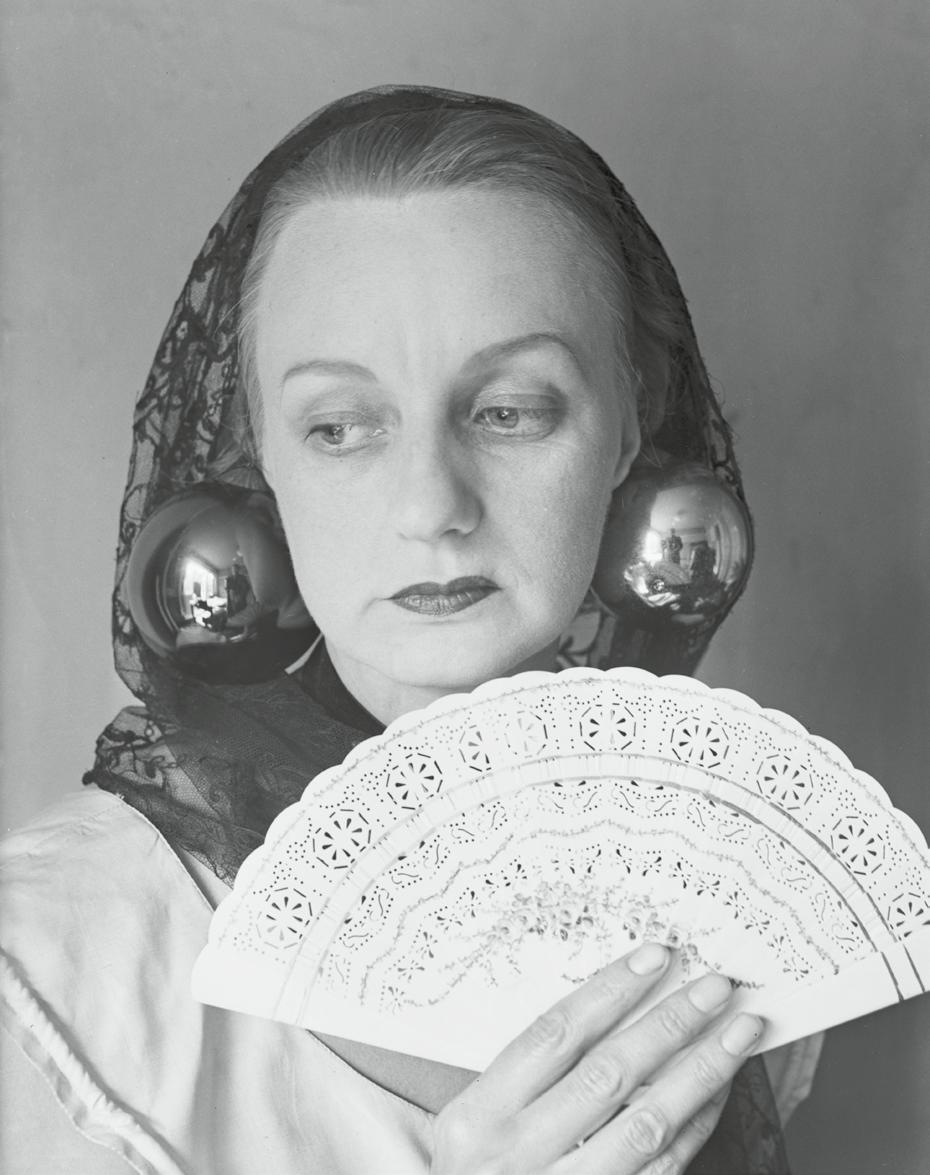
Flowers and landscapes often appear in her adult work, in addition to figurative studies of mythology and the Bible, and abstracts in which colour takes on an occultist significance. Her writings also explore these ideas and drew on her study of the Kabbalah, alchemical treatises and the writings of Aleister Crowley, as well as her participation in the Hermetic Order of the Golden Dawn. Where many in the European avant-garde
Left
Fantasy: Ithell Colquhoun
Right
Ithell Colquhoun (1906-1988) Sunflower signed and dated ‘Colquhoun/36.’ (lower right) oil on canvas 56 x 46cm (22⅛ x 18⅛in)
Estimate: £20,000 - 30,000 ($25,000 - 40,000)
engaged with occultism, Colquhoun practised it. Inculcating others in spiritual progress was critical to her art.
In 1929, while studying at the Slade, Colquhoun painted Nativityand JudithShowingtheHeadofHolofernes. Both are in a classical, monumental painting style, reminiscent of Picasso’s 1920s neo-classical nudes and Fernand Léger’s heavy-limbed ‘tubist’ figures, on the one hand, and the social realism of Thomas Hart Benton’s and Diego Rivera’s murals,
on the other. Nativity’s androgynous couple in bohemian clothing speaks to the birth of a new age as well as the birth of the Christ child, while the Brutalist building in the background signifies new directions with its emphatically modernist architecture. JudithShowingtheHeadofHoloferneswon Colquhoun first place in the Slade’s prestigious Summer
| Bonhams Magazine 36
‘‘A
“My life is uneventful, but sometimes I have an interesting dream”

Bonhams Magazine | 37
Composition Prize in 1929. Founded in 1871, the Slade was at the forefront of the move to women’s rights, allowing them equal opportunities to develop as artists. Colquhoun’s triumphant Judith is a subversive virago, perfect for this exciting period of change that followed the Representation of the People Act of 1918 finally granting some British women the right to vote.
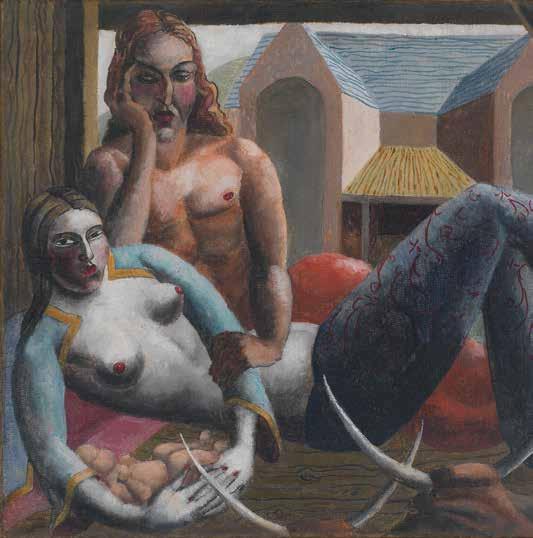
New avant-garde ideas (notably surrealism) were now infiltrating Britain, where modernism had too long been dominated by formalist concerns alone. For the surrealists, magic, alchemy and occultism were vehicles for the overhauling of traditional hierarchies. Colquhoun wrote in 1930 that the occult could overcome oppositions, leading to the “communion” of human and non-human, “metal and deity, beast and precious stone, the months of the year and parts of the human body”. As with fellow British artists Leonora Carrington and Eileen Agar, whom she met in 1936, Colquhoun turned to Paris and surrealism for inspiration and support, but also strove to bring their ideas back to Britain, recognising that surrealism went beyond national borders.
Surrealism quickly inspired Colquhoun to break away from the outmoded Slade school style – “to draw in the style of Michelangelo but to paint in that of the French Impressionists” – and embrace the unconscious impulse and the “influence of Dalí’s technique” instead. This included experimentation in all forms of “pure psychic automatism”, dreamscapes, depictions
Above Ithell Colquhoun (1906-1988)
Nativity, 1929 41cm x 51cm (16⅛in x 20in)
Estimate: £6,000 - 8,000 ($8,000 - 10,000)
of sexual desires and fears, paranoia and double images, as she discovered when she visited Paris in 1931 and in 1939.
The International Surrealist Exhibition at the New Burlington Galleries in London in 1936 was momentous for Colquhoun. At the opening, Dalí attempted to deliver a lecture wearing a deep-sea diver’s suit and holding two hounds on a leash, while the British artist Sheila Legge wandered among the crowds as the ‘Surrealist Phantom of Sex Appeal’, in an evening gown and headdress made of roses, carrying a raw pork chop. Colquhoun noted the huge impact this exhibition had on her: within three years, she was exhibiting in London alongside the British surrealists in the ‘Living Art in England’ exhibition and in a joint exhibition with Roland Penrose at the Mayor Gallery on Cork Street.
This impact was multifaceted and nuanced, as revealed by Colquhoun’s paintings DoubleCoconut(1936) and Sunflower(1936) – the latter to be offered in September at Bonhams’ ‘Blazing a Trail’ auction of works by female artists – which give the genres of the still life and the portrait new surrealist frisson. The watercolour-on-silk painting of an exotic coconut plant suggests testicles and female buttocks, a Dalí-like double image that gives erotic significance to a nature study. Similarly, the painting of the sunflower is much more than a still life. Helianthusannuushad a particular place in modern art and literature as a symbol of desire. Blake’s illustrated poem ‘Ah! Sun-flower’ (1794) spoke to his

| Bonhams Magazine 38
Left Ithell Colquhoun’s Anthurium, sold by Bonhams for £258,000 in 2022
doctrine of free love, as symbolised by the flower’s reaching for the sunlight, while the surrealists seized it as a symbol of alchemical desire, magnifying how solin the French name for the flower (tournesol) incorporates the Latin word ‘sun’, ‘earth’ in French, and the agent ‘sol’, used in litmus tests, denoting chemical change. Colquhoun’s flower thus pays homage to the transformative power of desire. “Sometimes I copy nature,” she wrote, “sometimes imagination: they are equally useful. My life is uneventful, but I sometimes have an interesting dream.”
Colquhoun’s membership of the London surrealist group was short-lived, with E.L.T. Mesens ousting her for her occultist interests in 1940, even though occultism remained central to international surrealism. Her experimentation with automatic painting techniques blossomed as she sought new divinatory processes, a further fusion of surrealism and occultism. Paint began to take on an emphatically material role, acting as an alchemical agent so that transformation literally takes place on the surface of the canvas. Her experiments included blowing paint, decalcomania (pressing ink or paint together to create blob-like forms), fumage (making smoked patterns on paper with a burning candle) and parsemage (sprinkling coloured chalk or charcoal on to water, then dipping paper into it). She aligned these four techniques with the four elements: air, earth, fire and water.

From the 1940s with works such as Gorgon(1946) and Arbour(1946) through to the tarot cards (Taroseries) she
Estimate:
($6,500 - 9,000)
designed in 1977, Colquhoun viewed these automatic painting processes as a means to enter radically different spiritual realms: with OilonaWetRoad(1963), the eye delves into an amoebic mass to discover a creature that is part woman, part sea creature.
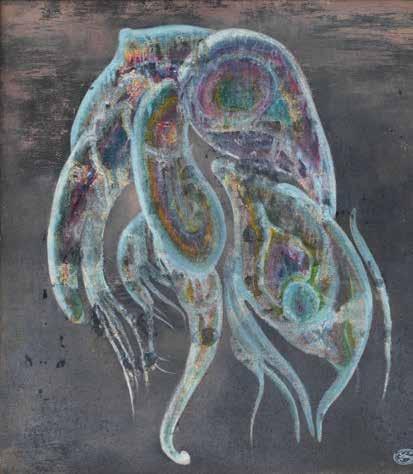
In her book TheLivingStones:Cornwall(1957), Colquhoun noted the importance of “the strange powers” of Cornish geography; she had moved to the county in 1947, staying until her death. TheDanceoftheNineOpalspays homage to the importance of the real British landscape to her surreal painted ones, with the Merry Maidens stone circle in Penzance, Cornwall, morphing into a universal eulogy to goddess energy. Colquhoun’s TheBookoftheDeadtranslation, Masonic activities, occult practices, and ordainment as a Priestess of Isis in 1977, all remind us of the inseparability of her art and life. Poetically entangling magic and the marvellous, occultism and automatic technique, dancing maidens and phallic stones, she not only rejected the confines of her world, but re-enchanted it for future generations.
Alyce Mahon has published books on de Sade, surrealism and eroticism in art.

Sale: Blazing a Trail: Modern British Women
London
Wednesday 20 September at 3pm
Enquiries: Janet Hardie +44 (0) 20 7393 3949 janet.hardie@bonhams.com
Bonhams Magazine | 39 BLAZING A TRAIL: MODERN BRITISH WOMEN
Left Watercolour self-portrait, (c.1927-30) by Ithell Colquhoun
Above Ithell Colquhoun (1906-1988) Oil on a Wet Road, 1963 73.6cm x 66.3cm (29in x 26⅛in)
£5,000-7,000
©Tate
In at the deep end
Greg Louganis achieved diving perfection at the Olympics – and now he wants those medals to leave a legacy, says Harry Fisher
Main image
When diving feels like flying: Louganis in action
Somebody really ought to give Greg Louganis a medal.
That may sound a strange thing to say about a five-time medal-winning Olympian, the man whom all the experts call the world’s greatestever diver. As the only male athlete to have won backto-back gold medals in both springboard and platform diving events and the only man to sweep the diving events in consecutive Olympics, Greg Louganis has been festooned with medals more than almost anybody on earth. None of his achievements, however, is more deserving of honour than his actions today.

Three of Louganis’s Olympic medals are about to be auctioned by Bonhams. They are the Gold he won at the 1988 Summer Olympics in Seoul; the Gold he won in Los Angeles in 1984; and the Silver he was awarded at his first Olympics in Montreal, at the age of 16. He has also rediscovered in his Topanga house the actual bathing suit he wore at those Montreal Games, and is adding that to the sale.
In putting them up for sale, Greg’s intention is to ensure that “the medals should have a life beyond me. The achievements are all in the history books but each medal has a story and to share that story can do some good.”
To that end, he is donating a portion of the proceeds of the auction to the cause that he has supported throughout his adult life – LGBTQ+ rights. Specifically, the money will go to the Damien Center AIDS service organisation in Indianapolis and its One Home Capital Campaign initiative, which is in need of a new building.
Louganis has been aware of the organisation since the 1980s, and says: “It’s a kind of one-stop shop providing services for people living with HIV/AIDS. There’s healthcare, mental care, dentistry, a food bank and so on. They’re bursting at the seams. My goal is to raise enough money where I can name a welcome centre after Ryan White [the haemophiliac Indiana teenager who became a national figure after he was barred from attending high school after having been diagnosed with AIDS in 1984].
40 | Bonhams Magazine
Getty IMages
There is also a welcome lounge. I want to name that after my mom, Frances Louganis.”
Frances, who inspired and supported Greg’s progress throughout his career and died in 2004, was Greg’s adoptive mother. He had been born in 1960 in El Cajon, California, to a teenage girl of Swedish descent and an equally young father who was Samoan. The baby was taken into the state’s fostering system and, when he was eight months old, was adopted by Frances and her husband Peter, who worked in California’s fishing industry and was of Greek descent.
They named the infant Gregory Efthimios Louganis. The couple already had an adopted daughter who was crazy about dance, gymnastics and acrobatics. The little boy started imitating her in all those activities –and trampolining – when he was as young as 18 months. He was nine when the family acquired a swimming pool, and Greg then combined all of those pursuits into diving. He had discovered his God-given talent.
He also got into every kind of trouble and was lucky not to have been caught up in the justice system, from which he might never have emerged. The Louganises had never concealed the truth about his birth but, by his own account, Greg was deeply disturbed by the idea that his own parents couldn’t love him enough to look after him. That disturbance led him into “a horrible rebellion. I was out of control and wouldn’t let anybody in.”
Diving saved him. Through a succession of high schools in southern California, he progressed in his early teens to the 1974 Junior Olympics in Lincoln,

Bonhams Magazine | 41
“None of his achievements, however, is more deserving of honour than his actions today”
$600,000 - 900,000
(£470,000 - 700,000)
$200,000 - 300,000
(£160,000 - 240,000)
(£630,000 - 940,000)
Nebraska. There, he was spotted by Dr Sammy Lee, the extraordinary diver of Korean descent, born in 1920, who had won Gold for the USA in the 10m diving event at both the 1948 London Olympics and at Helsinki 1952.
Dr Lee coached 16-year-old Greg to compete at the 1976 Montreal Olympics. In the tower event, Greg won the Silver medal that is in the Bonhams sale. Two years later, under the tutelage of the legendary Ron O’Brien, he won the World Championship for the first time. O’Brien understood that Greg was a performer, rather than a competitor and so was able to coach him in a way no one else did. They are still close to this day.
Greg was diagnosed HIV-positive six months before the 1988 Seoul Olympics. That didn’t stop him winning two Gold medals. In the 10m final, he won with a dive still regarded as one of the most perfect ever executed, and accumulated a total of points that


| Bonhams Magazine 42
has never been exceeded.
Above left A Greg Louganis 1984 Olympic Gold Medal, Men’s Three-Meter Springboard Estimate:
Above centre A Greg Louganis 1976 Olympic Silver Medal, Men’s Ten-Meter Platform Estimate:
Above right A Greg Louganis 1988 Olympic Gold Medal, TenMeter Platform Estimate: $800,000 - 1,200,000
It’s not easy now to remember that there was a widespread view that HIV was so virulent that it would kill on the most innocuous contact. It was partly in order to combat such misplaced prejudice that Greg Louganis devoted much of his life after Seoul and retirement from competitive diving. He came out publicly as HIV-positive; worked with the UN Human Rights Committee to defend the human rights of
dogs in agility competitions. Being with his dogs gives him, he says, “a sense of security, company and unconditional love”.
Further to his search for love, in 2013 Greg Louganis entered one of the first same-sex marriages in America with his partner Johnny Chaillot (they were divorced in 2022, but remain good friends), and he was also reunited with his natural parents, those long-lost teenagers, bringing him peace, at last, with his turbulent past.
If, therefore, anybody is going to present Greg Louganis with a medal today, perhaps it should be the President of the United States. And perhaps that medal should be his country’s highest decoration: the Congressional Medal of Honor. He deserves it.
AIDS victims; joined the board of directors of the charitable foundation run by Princess Charlene of Monaco; and supported the Damien Center, which will now benefit from the auction of his medals.
Greg also mentored and coached young divers; published his autobiography; successfully ventured into acting on stage and film; and achieved national prominence – winning yet more medals – entering
Sale: The Greg Louganis Olympic Collection Los Angeles
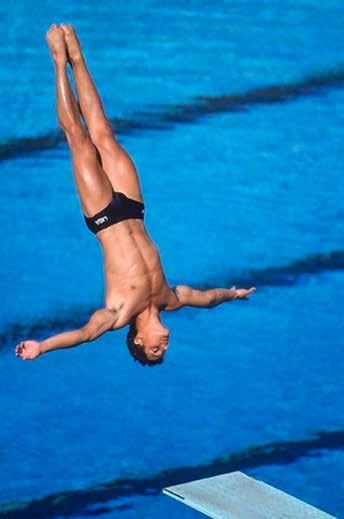


Thursday 14 September at noon
Enquiries: Catherine Williamson +1 323 436 5442 catherine.williamson@bonhams.com
Bonhams Magazine | 43 LOS ANGELES
Harry Fisher writes about sports and society.
“Louganis won with a dive still regarded as one of the most perfect ever executed ”
the
of
Opposite left Greg Louganis in 1984, the year he won two gold medals at the Los Angeles Olympics
Above Considered
greatest diver
all time,
Louganis combined elegance and precision
Right Louganis during the 1988 Seoul Olympics, where he won a further two gold medals
French connection
describes how taste changed
nyone familiar with the great masterpieces of Dutch Golden Age painting could probably list the furnishings favoured by its affluent citizens. Artists working throughout the Republic in the 17th century, perhaps most famously Jan Vermeer and Pieter de Hooch in Delft, Frans van Mieris in Leyden, and Gabriel Metsu in Amsterdam, supply us with luminous images of interiors combining the spare and the sumptuous. Here are the requisite bare chequerboard floors, tables covered by rich Anatolian or Persian carpets, costly Chinese blue-and-white porcelain, and humbler Delft pottery and tiles. Gilt-embossed leather panels line walls or upholster the square seats and simple backrests of so-called ‘Spanish’ chairs.
But what followed in the 18th century? The answer has only recently begun to emerge in its full complexity, and it is not to be found in picture galleries – genre paintings of domestic interiors fell from favour in this period. It is a question that evidently intrigued the connoisseurcollector Cornelis Paulus van Pauwvliet. He spent more than 50 years assiduously assembling furniture, silver, ceramics and clocks – and an extensive library
Left
Julien La Roy (1686-1759), Paris
An important mid-18th century French longcase clock 55cm x 31cm x 218cm (21½in x 12in x 85½in)

Estimate: £80,000 - 120,000
Below
A pair of Louis XV gilt bronze mounted Chinese ‘Clair de Lune’ celadon glazed porcelain garniture ewers

17cm x 10cm x 28.5cm (6½in x 3 ½in x 11in)
Estimate: £50,000 - 80,000
Opposite below
A fine Dutch Louis XVI marquetry and ormolu mounted secretaire a abattant
Attributed to Matthijs Horrix (1735-1809)
81.5cm x 44.5cm x 109.5cm (32in x 17.5in x 43in)
Estimate: £10,000 - 15,000
– all housed in his Amsterdam apartment a stone’s throw from the Rijksmuseum. These works of art outline the evolution of Dutch taste over the course of this relatively little-studied century and beyond, with pieces stretching back to the late 17th century and forward to the late 19th century. Barely a square inch of wall or tabletop was left unadorned. Perhaps the most striking characteristic of his apartment, however, was that, at first glance, one might be forgiven for thinking that it was in France.
French influence had already begun to inform the arrangement and the content of Dutch interiors by the 1630s, but the dissemination of the French court style was accelerated by the Revocation of the Edict of Nantes in 1685, which saw Huguenot
In 1685, the Huguenots were forced out of France. They fled to the Dutch Republic. Susan Moore
Barely a square inch of wall or tabletop was left unadorned in the Amsterdam apartment”
Right
craftsmen migrating to the Netherlands in pursuit of religious tolerance. Not least among them was Daniel Marot, draughtsman to Louis XIV, who was immediately appointed chief architect to William III, Prince of Orange, and set about transforming the palace and gardens of Het Loo.
This aristocratic French taste initially took hold in The Hague, the seat of the Dutch Republic’s princely stadtholders. The merchant families of Amsterdam in the north were more reluctant converts. Even so, French decorative arts arrived in great waves in both cities, those in the taste of Daniel Marot – which became known as the William and Mary style – proving sufficiently popular to delay the advent of the Rococo, which had swept through much of Europe, until around 1745. William IV attempted to establish Rococo as a court style during his brief reign as stadtholder (1747-51), emulating before his untimely death the ambitious patronage of his relatives Frederick, Prince of Wales, and, in Berlin, Frederick the Great.
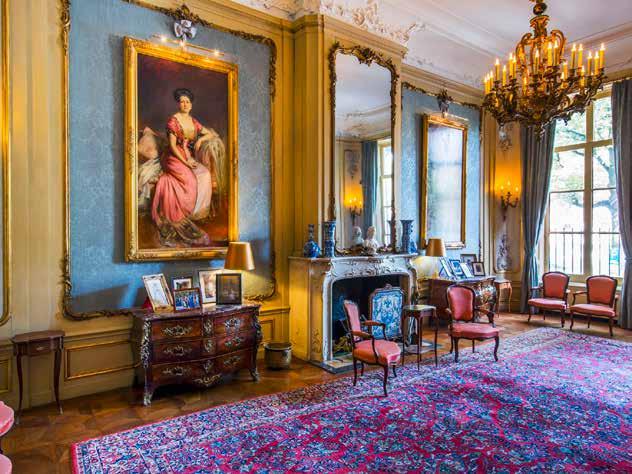
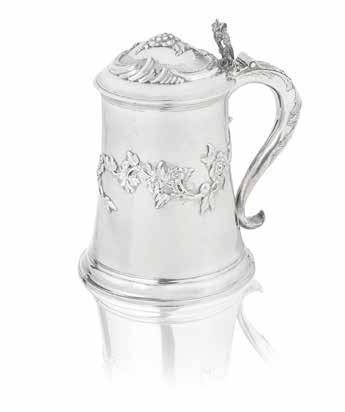
Such were the quantities of French veneered furniture arriving in the Dutch Republic by the 1770s that the protectionist furniture guilds of both Amsterdam and The Hague complained that their craftsmen were going out of business. They had success in Amsterdam at least, where foreign wares could be sold for a further three months only, so long as they were stamped with the mark of the Guild of St Joseph. Thereafter, imports to the city were restricted to the annual fairs, where any merchant or craftsman could take a stall.
Hardly surprisingly, local cabinet-makers responded to domestic demand by making furniture in the French taste. One, the German-born Matthijs Horrix (1735-1809), proudly proclaimed his emporium to be in decommodevanParijs– ‘in the manner of Paris’. His was the largest and best-known workshop in The Hague, specialising in luxurious ormolu-mounted furniture with
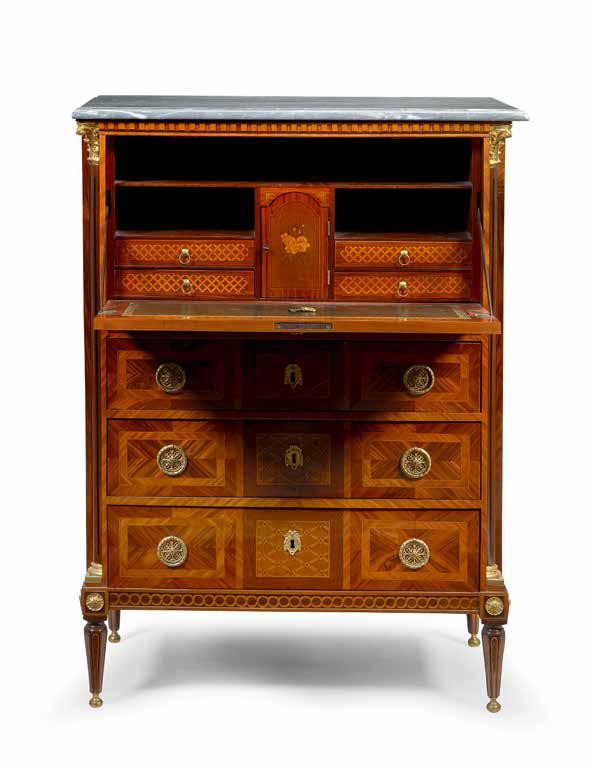
45
The Blue Drawing Room at Museum van Loon in Amsterdam
2003, Peter-Kooijman
Below
An important and very rare late 18th century Dutch brassmounted mahogany musical table clock
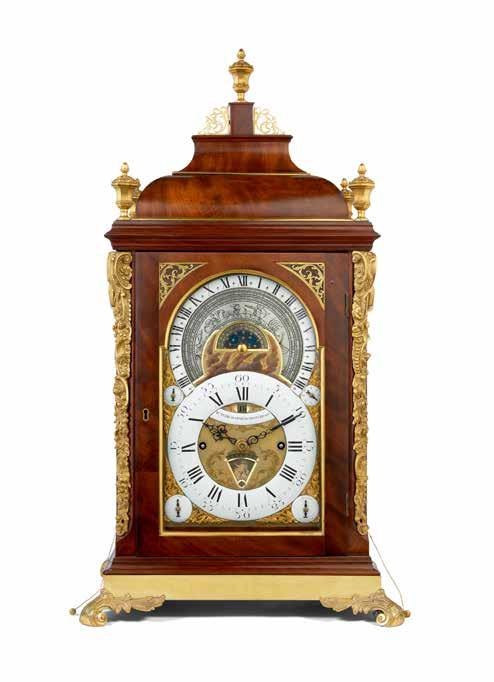
41cm x 29cm x 75cm
(16in x 11in x 29½in)
Estimate: £30,000 - 50,000
inlaid marquetry decoration. Three years after he enrolled in its guild as a master cabinet-maker in 1764, his success was assured by receiving the prestigious commission from the newly married stadtholder Prince William V and his bride, Princess Wilhelmina of Prussia, to supply them with ‘Commodes, Tables etc’ for their residence in the city, and further furnishings for Het Loo. Virtually all Princess Wilhelmina’s annual accounts reveal deliveries of marquetry furniture from Horrix.
Paulus van Pauwvliet had a particular admiration for this cabinet-maker, and the sale includes three pieces
attributed to him. Two ormolu-mounted Dutch Louis XVI commodes with plain grey marble tops are typical of his refined restraint, but there is no mistaking their costly exotic woods, imported from the New World. Here, tulipwood and purplewood are combined with sycamore. Of tripartite design, the central door of each commode is inlaid with floral ribbon-tied medallions and flanked either by flower-filled urns or ribbon-tied musical trophies. Floral sprays or Classical urns ornament the side panels. These are market rarities, as indeed is the even more

“In 1813, when anti-French sentiment was at its height, English dealers were scooping up these treasures…”
2003, Peter-Kooijman
This image
The Palais Het Loo in The Netherlands
its 18th-century French counterparts, left the country in the early 19th century after the end of the Napoleonic occupation in 1813 when anti-French sentiment was at its height. No doubt, many of the English dealers scooping up these treasures presumed they were buying French furniture rather than pieces in the French style. Certainly, the 5th Duke of Buccleuch acquired pieces by both Horrix and his Amsterdam counterpart, the German-born Andries Bongen, from the London dealer Edward Holmes Baldock, who bought extensively in Holland. It is only in recent years that scholars have begun to comprehend the extent to which French furniture was imported into, or made in, the Dutch Republic during the 18th century.
Dutch silver – vessels and boxes, not least for tobacco – similarly spans the century. It also reflects the presence and influence of foreign craftsmen on native traditions. Among them was the Swede Johannes Schiotling, who settled in Amsterdam around 1762, and employed several silversmiths from Sweden and Germany, all familiar with the northern Rococo tradition. His tankard of 1767, plain but ornamented with a floral garland, flowers and shells, took a bow in the Rijksmuseum’s seminal Rococo exhibition of 2001-2002.
Typical, too, are the delightful Dutch Delft wall plaques, painted with shipping scenes, flowers, or in imitation of Japanese or Chinese porcelains. Yet it seems that Paulus van Pauwvliet was no less enamoured by grand Louis XV gilt-bronze mounted Chinese monochrome porcelains, as well as garnitures of urns and vases confected from semi-precious hardstones.
Like the furniture and silver, his impressive clock collection boasts rarities among the Dutch pieces, among them a musical table clock by Rutgerus van Meurs. In terms of the spectacular, however, the fine English and Dutch pieces are both cast in the shade by the imposing longcase clock with an ormolu-mounted case by A Dubois and a movement by Julien Le Roy, the horologerduRoi
In this context, what Paulus van Pauwvliet chose for his walls was unexpected: a sequence of small oil paintings
A pair of French ormolu mounted banded amethyst quartz urns

Early 19th Century
17cm x 8cm x 27cm
(6.5in x 3in x 10.5in)
Estimate: £3,000 - 5,000
A Dutch Delftware plaque with moulded border, circa 1750-60 36 1/2cm x 43cm (14in x 16½in high)


Estimate: £6,000 - 8,000
A Dutch Deltfware Plaque, circa 1740-60
34cm x 38cm (13in x 14.5in)
Estimate: £7,000 - 9,000
An important Dutch Louis XVI marquetry and ormolu mounted commode

Attributed to Matthijs Horrix (1735-1809)
117cm x 57cm x 92cm (46in x 22in x 36in)
Estimate: £30,000 -50,000
Impressionist Johan Jongkind’s SortieduportdeHonfleur of 1866 neatly linking the two. Bearing the highest estimates are one of the Belgian neo-Impressionist Théo van Rysselberghe’s views of the Dutch port of Veere of 1906 and Kees van Dongen’s Deauville,leChampde Courseof around 1935. It is hard to imagine that this avid collector had time to attend the races himself.
Susan Moore writes for the Financial Times
Sale: Cornelis Paulus van Pauwvliet: An Important Dutch Collection
London
Tuesday 21 November at 1pm
Enquiries: Charlie Thomas +44 (0) 20 7468 8358 charlie.thomas@bonhams.com
Bonhams Magazine | 47 LONDON
Here comes the night
Diane de Beauvau-Craon ate sweets with Timothy Leary, lived with Robert Mapplethorpe, partied with Mick Jagger. She looks back at the crazy days of ’70s New York and ’80s Paris.
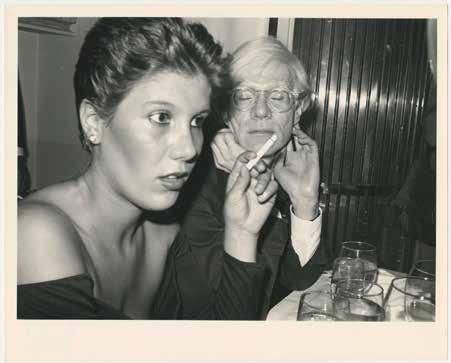
Lucinda Bredin tries to keep up...
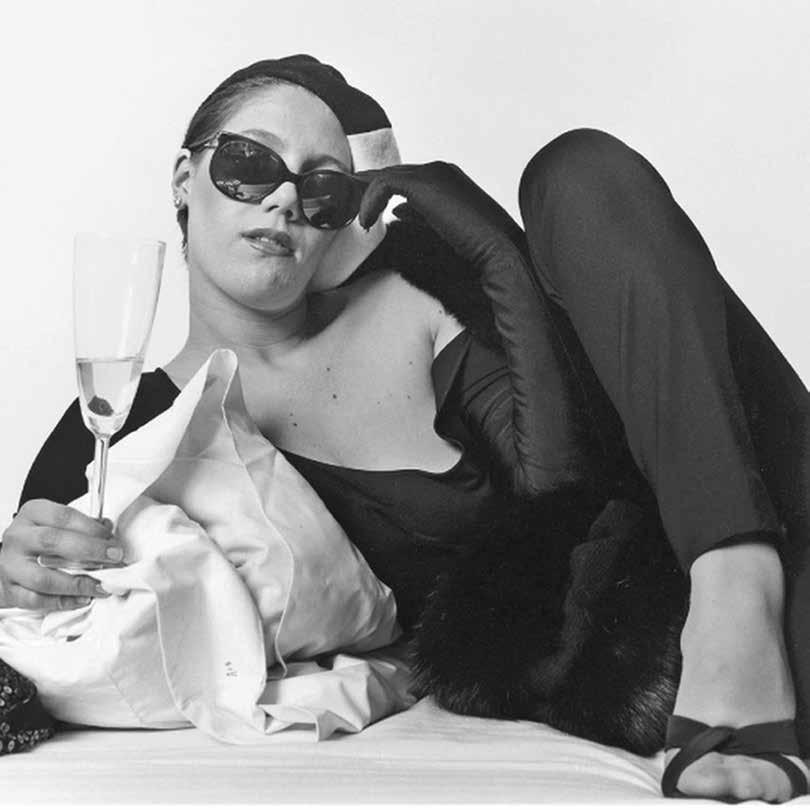 © Robert Mapplethorpe Foundation
© Robert Mapplethorpe Foundation
Opposite ’80s royalty: Princess Beauvau reclining with a glass of champagne, and smoking with her friend Andy Warhol (“he was very kind and protective”)
Left Robert Combas (born 1957)
En plus, 1985 143 x 197.3cm (56 x 77in)
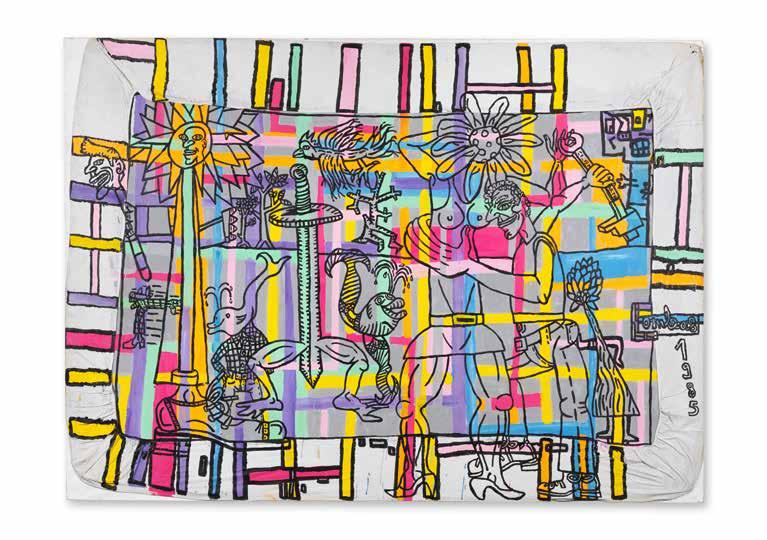
Estimate: €60,000 - 80,000 (£50,000 - 65,000)
Below Philippe
Diane de Beauvau-Craon has a way of being at the right place at the right time – well, as far as she is concerned. Her parents, her beloved father, Prince Marc de Beauvau-Craon, and her mother, daughter of the Bolivian copper magnate Antenor Patiño, may have had a different view. Diane was in New York during the Studio 54 years. She was in Tangier during the ’80s when toutlemondedescended. She was in Paris when the hippest club, Le Palace, was in full swing. It’s as if her and the zeitgeist were magnetically linked. “I like extremes,” as she puts it. Moreover, she has survived: “I’m probably one of the last living figures of the swinging ’70s and ’80s. At one point, I literally threw all my address books into the fire because 90 per cent of my
friends had died. I would say most from AIDS, and 20 per cent had OD’d. So that’s why sometimes I find it very, very unfair. Why the hell am I still here?”
Diane, whippet-thin, a slick of black hair and red lipstick, is sitting in her apartment off Boulevard StGermain. She is infectiously warm, with exquisite manners, irrepressibly curious and only too happy to serve up a feast of information. There’s a saying that if you remember the ’70s, you weren’t there. But Diane, who has just published her memoir Sansdépartir(which is based on the family motto: ‘Without Fail’), recalls quite a lot, all things considered. She evokes a world of drugs ’n’ decadence, of working for the fashion designer Halston, of living with Robert Mapplethorpe, and of partying with
Steve Rubell, the owner of Studio 54 – all of which was overseen by the ringmaster, Andy Warhol.

She was particularly close to Warhol. “A lot of people at that time didn’t really consider him an artist – they thought he was a publicist. He had to battle to be respected. I think what people underestimate was how disciplined he was. I would say that his mind was on work all the time. He didn’t take drugs, he didn’t really drink, but the world of excess certainly interested him as an observer. There was, well, a bunch of courtesans that surrounded him, all these boys were beyond beautiful, but it definitely wasn’t for the looks of Andy that they were there. It was for the spirit that was coming out of the Factory. Who created that spirit? That was Andy. He was at the epicentre.” She adds, “He was also very kind and protective towards me.”
This magnetic attraction to charismatic figures began at an early age. Her parents probably thought the 14-year-
Bonhams Magazine | 49
“I threw all my address books into the fire because 90 per cent of my friends had died, most from AIDS”
Morillon’s photograph of Diane with Pierre Maraval at Studio 54, 1980
EIGHTIES SALE, PARIS
© Philippe Morillon
old Diane would be safe in a Swiss boarding school in the middle of a deep dark canton. But no. This was someone who could get into trouble in a sweet shop – for this was where she bumped into none other than Timothy Leary, the guru who exhorted a generation to “turn on, tune in, drop out”. I mean, what were the chances? “I bought so many sweets that he asked if I wasn’t overdoing it a bit.”
Leary was on the run from the FBI andthe Black Panthers, so he was holed up in the chalet of an arms dealer. “He probably found that I was quite funny with all my bundles of sweets in my arms. We walked out of the store together and he invited me for tea. It just happened like that – as with all my most memorable encounters.” Being seen in public with an older man who was wanted by the FBI was an encounter too far for Diane’s school. She was invited to leave. But meeting Leary gave her “brilliant ideas for the future”, as she puts it.
One of those brilliant ideas was to turn up in New York, aged 17, on the arm of her fiancé, a gay scion of an industrial fortune. He went home, Diane stayed. Needing a focus – Diane always wants to be in the midst of the action – she was hired as a ‘consultant’ to the fashion designer Halston. She was paid in jewellery. At a dinner party, Warhol came up with her soubriquet, Princess BoBo, and the cover of Warhol’s Interview magazine followed, with portraits of Diane taken by Robert Mapplethorpe. Diane moved in to the artist’s loft for a few months, and the two began to explore the ripe Meatpacking District, where fetish clubs such as the Mineshaft were. As Diane says, “I was one of the few women that went there. I have always been more comfortable around homosexual men. I asked a friend why this was. He replied: ‘You’ve got a mind of a homosexual in the body of a woman’.”
As the ’70s turned into the ’80s, the party began to pall. Diane went on honeymoon to Tangiers with her second husband – and got pregnant by the man who became her third. She explains this change of scene in a very
Top left Patrick Nagel (1945-1985) Sans titre (noble), 1982 acrylic on canvas 101.7 x 76.5cm (39¾ x 29¼in)

Estimate: €80,000 -120,000 (£65,000 - 100,000)
Above Ettore Sottsass (1917-2007) Murmansk cup, 1982 Memphis Edition, stamped silver 30 x 35.5cm (11⅞ x 13¾in)

Estimate: €6,000 - 8,800 (£5,000 - 6,500)
Opposite, top and bottom left Philippe Morillon’s blackand-white snaps of Diane with her lover Jacques de Bascher at l’Opéra de Paris in 1981, and of Roland Barthes at Le Palace in 1979
Opposite, top right Morillon’s 2017 inkjet picture of Diane with Warhol at Château d’Haroué
Opposite, bottom right Sandro Chia (born 1946) Sight knight plight, 1987 signed and dated ‘87’ oil on canvas 221 x 274.3cm (87 x 108in)
Estimate: €140,000 -180,000 (£120,000 - 155,000)
matter-of-fact way. “I find it extremely boring to have the same life, or to try to repeat the same life in a different place. In that case, why the hell do you move? And I never, never, never compare places.”
Which brings us to Paris in the ’80s, which is the theme of a sale at Bonhams Cornette de Saint Cyr
on 21 September that celebrates that decade. The city of lights had been a bit of a backwater in the ’70s, but by the ’80s clubs such as Le Palace and Privilège were having their moment in the limelight, with demi-monde figures such as Cuban DJ Guy Cuevas. “Guy was extraordinary. Paris had never seen or heard anything like him,” said Diane. In many ways, she feels that Paris experienced the same sense of release as New York in
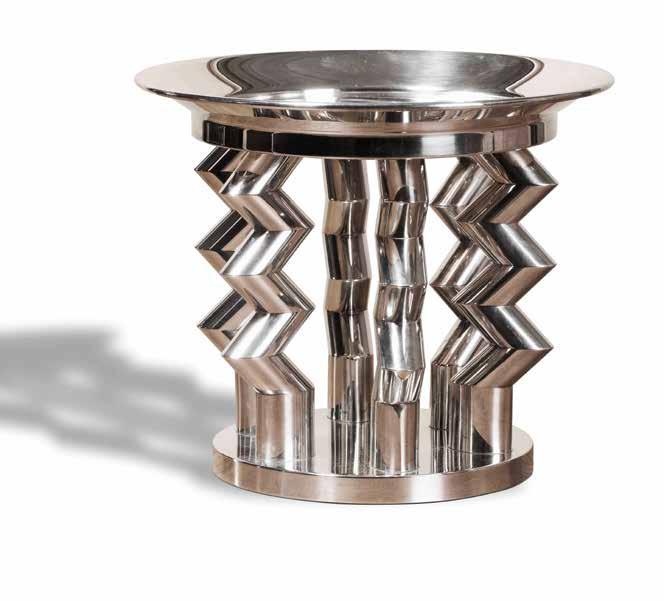
LOREM IPSUM | Bonhams Magazine 50
“In Paris, she had a polyamorous affair with Jacques de Bascher and Karl Lagerfeld”
the ’70s. “It was like having a double dose of freedom.” One of her defining relationships in Paris was a polyamorous affair with Jacques de Bascher and Karl Lagerfeld. “Jacques came to Tangier to bring me back to Paris – I was the only woman he ever loved. It wasn’t even a conversation piece that he was a homosexual.”

The music stopped – abruptly – when, in 2001, she almost died in a Parisian hospital, having being admitted unconscious. She took a decision to renounce drink and drugs – although not smoking (“It’s my only vice”) – and to keep the story going. “Because I’m curious about life. I adore people, I find that the human being is fascinating. There’s always, always, always something good to get out of somebody.”
Lucinda Bredin is Editor of Bonhams Magazine.
Sale: Eighties
Paris
Thursday 21 September at 2pm
Enquiries: Patrick Masson patrick.masson@bonhams.com

You had to be there
Philippe Morillon on capturing the ’80s
The series of black-and-white silver photographs that make up the Bonhams Paris exhibition PhilippeMorillon sousl’oeildeDianedeBeauvau-Craonwas taken between 1970 and 1985, when I was a fashionable young illustrator working in advertising and for magazines in a style known as ‘retro hyperrealism’. To make this kind of illustration, I needed photographic source material, so I had to take photographs, even though I wasn’t a photographer. I also took a lot of very spontaneous photos – of my friends, our nightlife – with no specific aim except to ‘finish’ the 36-exposure rolls of film that same day or night, to avoid wasting film when they were developed. For a gay boy my age, it was a very fun time in Paris, with a whole gang of ‘hip’ people going out a lot and very late. Drugs were in circulation and the night went by fast. Nightclubs like Le Palace, Club 7 and Bains Douches saw us almost every night. So there are photos taken for the illustrations, official portraits for magazines, and snaps taken at random (like mobile phone shots today) that were barely looked at at the time. Many weren’t published: nobody has even seen them – until now.

PhilippeMorillonsousl’oeildeDianedeBeauvau-Craon BonhamsCornettedeSaintCyr,6AvenueHoche,Parisfrom19-21September.
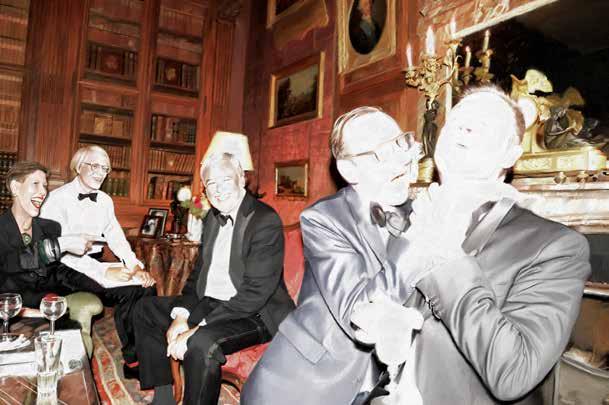 © Philippe Morillon
© Philippe Morillon
© Philippe Morillon
© Philippe Morillon
© Philippe Morillon
© Philippe Morillon
Mortal fear
Artists have confronted death in myriad forms over centuries. From the vanitas to vitrines of taxidermy. Sasha Thomas is brave enough to take a close look

This page Jim Dine (b.1935) The Face in the Rage of Red 1986 oil on canvas 210.8 x 180.3cm Estimate: $20,000 - 30,000
Death is one of the few certainties of life. Be you king, conqueror, pope, or peasant, it comes for us all. For many this macabre fact is not something to dwell upon. For others, it’s an obsession.
It was through an interest in anatomy that the collector Richard Harris became fascinated by depictions of death and started to build his wide and impressive collection, a selection of which will be offered by Bonhams in a dedicated online sale, TheDanceofDeath, this autumn.
As shown in the exhibition Death: ASelf-Portraitat the Wellcome Collection in London in 2012, Harris’s fascination with these macabre works runs from early etched mementomori, drawings of the dansemacabreand Old Master vanitas paintings, to modern and contemporary works – by the likes of Mapplethorpe, Warhol and Dumas, all of whom share with their ancient predecessors an obsession with the fragilities of the human body and with the inevitability of death.
In Classical antiquity and the era of early Christianity, an artistic trope began to take root: the mementomori. The Latin phrase simply means ‘remember you must die’, a warning that crosses class and social barriers. As philosophers, such as Plato and Epictetus cautioned, arrogance must be kept in check, and all must be reminded of their earthly mortality. The expansion of
Left Albrecht Dürer (1471-1528) Four Horseman, from Apocalypse, 1498 39.4 x 28.1cm
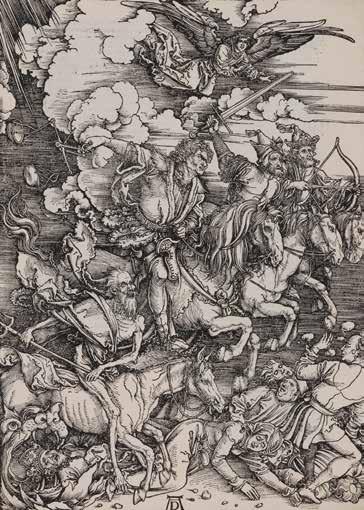
Estimate: $20,000 - 30,000
Right Odilon Redon (1840-1916) Vers une autre image graphite on paper 16.6 x 13.9cm

Estimate: $15,000 - 20,000
Christianity hardened the reminder into a warning: ‘remember the life hereafter’.
The message echoed down the centuries in countless artistic depictions: perhaps a skull would feature, perhaps bones, an hourglass, wilting flowers, or a coffin. In early engravings, such as those by Albrecht Dürer (1471-1528), Bible passages might be distilled into a cautionary motif, with TheFourHorsemen– from his 1498 series Apocalypse– the most famous. These visual warnings now had a much wider audience – the first printing press with movable type was introduced in 1440.
In the Late Middle Ages, the artistic allegory of the dansemacabre– ‘the dance of death’ – came to prominence, with the NurembergChronicle(1493) offering one of the earliest examples. Skeletons or a personification of death itself were shown, summoning people from all social strata – often the Pope, a king, a labourer and a child – to dance to the grave. Death is at once the great equaliser and a comically sinister figure, and the dance intrigues as much as it terrifies. Such works flourished against the backdrop of famines and the Black Death. With death a looming presence in daily life, relief was sought both in penance and in amusement.
Key to every warning was vanitas–again from Latin, this time meaning ‘vanity’. Becoming a genre of art in its own right, vanitastook hold in 16th-century Europe.
Above Robert Mapplethorpe (1946-1989)
Skull Walking Cane, 1988 gelatin silver print 58.8 x 49.5 cm

Estimate: $10,000 - 15,000
Left George Tooker (1920-2011)

Vanity, 1978 lithograph on Arches paper 50.8 x 40.6cm
Estimate: $900 - 1,200
Emphasising the temporality of life and the futility of pleasure, paintings in this style adhered to mementomori tropes, mainly being still-life works with a skull as the key component, frequently accompanied by a mirror and decaying fruit. Some showed candles or bubbles to stress the fragility of life; how quickly that bubble can burst and the candle be snuffed out.
The body, whether depicted or implied, is, of course, central to any consideration of death. In the 19th century, images of the body exposed, in both lust and vanity, presented a stark warning to the debauched. Death lurks in the corners, waiting. In images of war, the body was exposed in a different mode: broken, wounded and vulnerable, the anatomy of death recurring as an expression of what it might mean to go from the realm of the living to the land of the dead.
But, whilst staring death in the face is an uncomfortable experience, it is important to remember that mementomoriis not just a reminder that you will die – it is a confirmation that you are still alive.
Sasha Thomas is Senior Press Officer at Bonhams.
Sale: The Dance of Death
New York, Online
Monday 23 October-Wednesday 1 November
Enquiries: Deborah Ripley +1 212 644 9059 deborah.ripley@bonhams.com
Bonhams Magazine |
53
Real Madrid
Madrid isn’t badly off for museums. Among the total of more than 50 are such top-flight treasure houses as the Thyssen-Bornemisza, the Reina Sofía, the Royal Academy of Fine Arts, and a slew of smaller establishments from the delicious Sorolla house-museum to the aristocratic collections of Lázaro Galdiano and Cerralbo. The cherry on this richly flavoured cake, it goes without saying, is a pinacotecathat must surely be counted among the world’s half-dozen greatest: the Prado.
If all this were not enough to confirm Madrid as a museum city with few rivals, the Royal Collections museum, which opened in June, may be the tipping point. It is being called “Spain’s most important museum project in decades”. This sounds like exaggeration, yet the quality of both the building – by architects Emilio Tuñón and Luis Moreno Mansilla – and its contents, showcasing the Spanish monarchy’s vast accumulation of art and antiques, is superb.
The location of the new museum is an assertion of its place in the cultural landscape of the city. Perched alongside the cathedral and Royal Palace on an escarpment overlooking the Sabatini Gardens, the Manzanares river and the Casa de Campo Park, it occupies a prime spot in what might be described as ground zero of historic Madrid.
In contrast to the florid neo-classicism of cathedral and palace, the building’s minimalist forms
in light-grey granite are so easy on the eye as to be almost self-effacing. That said, with no less than 40,000 square metres of exhibition space and a budget of €167m, this is a project on the grandest scale.
The Royal Collections has had a long and complex gestation. First adumbrated in 1998 under the government of José María Aznar, for the next quarter-century it was repeatedly held up by political and bureaucratic wranglings, financial crises, and a pandemic – not to mention the discovery of a key section

of Madrid’s original 9th-century Arab fortifications, now preserved and attractively displayed as a constituent part of the museum. As building work ground to a halt again and again, many madrileñoswondered if it would ever see the light of day.
The result, we can reveal, has been worth the wait. With a month to go before opening day, Bonhams Magazinewas granted an exclusive preview of the gallery by its director Leticia Ruiz, a distinguished curator whose CV includes 21 years as head of Spanish Renaissance painting at the Prado.
| Bonhams Magazine 54
The director of the breathtaking Royal Collections museum gives Paul Richardson a behind-the-scenes tour of Madrid’s newest cultural treasure
“It is… ‘Spain’s most important museum project in decades’”
Ruiz greets me in the reception area, where a string of words in black letters stands out against the stone wall above the ticket office. These are the names of the 23 ‘royal places’ (sitiosreales), ranging from palaces and country houses to convents and monasteries – from which the museum’s exhibits are drawn. (El Escorial, Aranjuez and the Monastery of Yuste are three that hispanophiles may recognise.) Like our British royals, Spanish monarchs have habitually amassed enormous hauls of precious things. But while in Britain these goods and chattels are Crown property, in Spain they belong to the nation under the designation Patrimonio Nacional (‘national heritage’). “So the museum’s assets derive from the Royal Collections, but they pertain to the Spanish people,” explains Ruiz.
If the halls of the Gallery seem particularly agreeable and well-ventilated, this is thanks to the 5-metre ceilings and to the building’s sophisticated air-conditioning system, which modulates temperature and humidity according to the nature of the work displayed. Deploying a discreet combination of granite, concrete, glass and oak, Tuñón and Mansilla’s building could never be accused of attention-seeking, unlike certain other blue-chip art museums we could mention. Not least, the architects have neatly overcome the formidable challenge of attaching the structure to what is essentially a 34-metre rock face, creating various levels on which the museum’s narrative unfolds in historical progression.
Opposite
The Spanish Royal Coach

Far left
Of the museum’s three major exhibition floors, two offer a semi-permanent overview of the major Spanish royal dynasties and their gorgeous stuff: A for ‘Los Austrias’ (that is, the Habsburgs) and B for the Bourbons. I sit with Ruiz on a padded bench close to a stupendous oil painting (it looks vaguely familiar) while the director details the exhaustive process of choosing just 650 pieces from the estimated 170,000 held by Patrimonio Nacional in the various ‘royal places’ across the country. In Ruiz’s opinion, the greatest Habsburg art collector was Philip IV, whose Titians and Velázquezs formed the nucleus of what would become the Prado Museum. “He was a king who was very much aware that what he had inherited from Philip II was one of the best picture collections in Europe at the time,” she tells me. “But Philip II himself had very good judgement as a collector. His taste was for Flemish painting, in which he took after his grandmother Isabel la Católica, and also Titian and the Venetian School. The nudes, he took to his palace at El Pardo. The religious paintings went to El Escorial.”

A good number of the pieces on show here were brought in from the Royal Palace just across the way – such as the polyptych of Isabel la Católica (dated 1496-1504) by Juan de Flandes and the mysteriously riderless WhiteHorseby Velázquez, undoubtedly two of the museum’s biggest draws. As Ruiz and I are talking, I realise the painting beside us is none other than Caravaggio’s SalomewiththeHeadofJohntheBaptist,

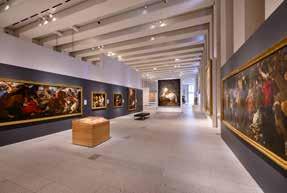
Bonhams Magazine | 55 PLATFORM
Leticia Ruiz, director of the Royal Collections museum, in front of Velázquez’s White Horse
Above left & right Goya’s portraits of Charles IV and his wife María Luisa de Parma
Left The galleries dedicated to ‘los Austrias’ (the Habsburgs)
Images courtesy of Patrimonio Nacional
a glorious work in moody chiaroscuro dating from the last year of the painter’s life. It was last hung in the Royal Palace, Ruiz says, in a less than ideal situation. “Here it looks divine, and shares a space devoted to Philip IV, which is absolutely the context of the work,” she says.

Many hail from further afield. El Greco’s Adorationof theNameofJesuswas formerly at El Escorial, while the great tapestry EncounterofAbrahamandMelchizedek, designed by Rubens for Philip II’s eldest daughter Isabel Clara Eugenia, is from the Monastery of the Descalzas Reales in downtown Madrid – whence it must return for Holy Week. (A certain amount of tact was required, says Ruiz, to persuade some of the ‘royal places’ to part with ‘their’ treasures, even if only temporarily. “But as soon as we open and they see how well the pieces are being looked after, I’m sure they’ll approve,” she confides.)

Through the tall windows can be seen the gardens of the Campo del Moro and the rolling woodlands of the Casa de Campo beyond. Ruiz reminds me that this large public park was once a royal hunting ground.
We take off on a brisk stroll through the museum’s airy halls, with the director pointing out some personal favourites – like the set of massive 17th-century Solomonic columns, slathered in gold and lapis lazuli, which were among the first pieces to be installed and were restored in situ.
The museum’s displays are nothing if not multifarious. Our progress takes us past clocks, fine china, furniture,
garments and photographs from the remarkable collection of the 19th-century queen Isabel II. “It’s a museum of museums. There’s a little bit of everything and something for everyone,” agrees Ruiz. Even children, I dare say, will find things to entertain them and fill them with awe. The extraordinary all-black carriage belonging to Mariana of Austria, wife of Philip IV, is an object of such Gothic gloom and grandeur it seems to have come straight out of a Tim Burton movie.
The genius of Ruiz’s curation lies in her juxtaposition of pieces to make an artistic or historical point, often

by cutting across genres. The immediacy of these connections certainly packs a punch. A giant 16thcentury Flemish tapestry (“We have the finest collection of tapestries in the world,” she remarks en passant) shows Emperor Charles V reviewing the troops in Barcelona, attired in what was said to be his favourite suit of armour. Meanwhile, on a plinth a few steps from the tapestry, stands the armour itself: quite a coup de théâtre.
On Floor B, which is devoted to the Bourbon dynasty and its acquisitions, my guide singles out an exquisite
| Bonhams Magazine 56
“The Archangel St Michael had to be winched into place by a team of 20 technicians”
Top The Campo del Moro façade of the Gallery of the Royal Collections

Above Madrid’s Royal Palace Right

commode by Matías Gasparini (commissioned by Charles III), describing it as “the Sistine Chapel of cabinet-making”. The huge ‘dessert’ or table centrepiece TheGloriesofSpainwas carved in marble for the Bourbon king Charles IV in 1802, and last used at the wedding banquet of the current Spanish monarch Philip VI. “The king and queen have visited twice to see how the works were progressing. They asked a lot of questions; I believe they’re delighted with the museum. When they saw the ‘dessert’ installed as an exhibit here, the king said he remembered it perfectly.”
A piece close to the director’s heart is TheArchangel StMichaelConqueringtheDevil, the masterpiece of Luisa Ignacia Roldán (‘La Roldana’), official sculptor at the court of Charles II and among the first Spanish female artists to achieve professional recognition. The sculpture, made of pinewood painted in vibrant rococo colours, is of a size (2.6 metres) and intricacy that it had to be winched into place by a team of 20 technicians.
We stand back to admire the sheer visual force and expressivity of this woman’s work, the vivid depiction of the youthful, loutish devil, and the curiously feminine features of the saint. The Archangel was tucked away at the back of the church in El Escorial, little appreciated. Now the work, fully restored and stunningly displayed, can be seen in a new and revelatory light. “This was for me the most exciting of all the arrivals – to see the angel make his last flight into the gallery,” remembers Ruiz.
Outside, under dazzling sun, tourists queue round the block for the Royal Palace. The new museum, it is confidently predicted, will soon take its place beside the Prado and Thyssen-Bornemisza as a must-see, with staff bracing themselves for 1.5 million visitors in the first year. The Gallery of the Royal Collections is important as a palimpsest of changing historical taste and a shop window for the immense artistic wealth of the Spanish royal sites. As its director observes, it “shows the best, most positive aspect of the relationship between art and power”. It deserves attention, not least, for its elegant resolution of a complex architectural conundrum.
Perhaps the most powerful effect of the new museum, however, is the way it reconfigures the cultural geography of Madrid, pulling the centre of gravity westwards from the Paseo del Prado. “What it does is bring the Royal Palace, cathedral and Gallery together as a single artistic nucleus,” says Ruiz. “Remember we are also very close to the Liria Palace, the Cerralbo Museum, the Descalzas and Encarnación monasteries, the Basilica of San Francisco El Grande with its Goya frescoes… so we’re directly on the site of Madrid’s 9th-century foundation, but also right at the centre of a new cultural axis for the city.”
Paul Richardson writes for the Financial Times and Daily Telegraph His books on Spain include A Late Dinner and Our Lady of the Sewers
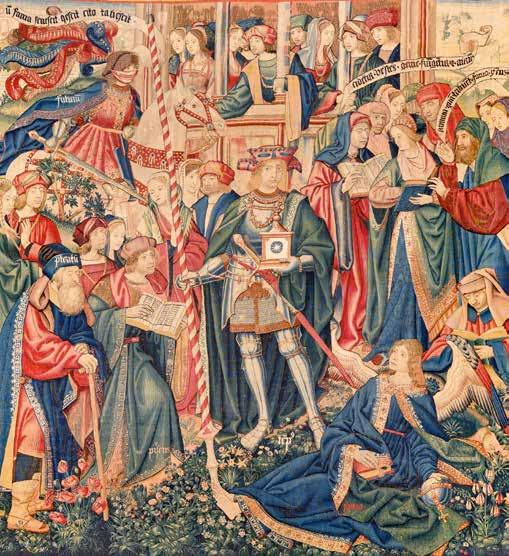
Bonhams Magazine | 57 PLATFORM
Gallery of the Royal Collections, c/Bailén s/n, 28013 Madrid (patrimonionacional.es/en/actualidad/galeria-de-las-colecciones-reales)
Opposite left La Roldana’s Archangel St Michael Conquering the Devil
Opposite top right Polyptych of Isabel la Católica by Juan de Flandes
Opposite bottom right Caravaggio’s Salome with the Head of John the Baptist
Detail from the 16th-century tapestry The Triumph of Time
Crossing the line
For all the revolutionary engineering that made the Lotus 79 a serial winner, it was the racing car’s beauty that sealed its legendary status, says Richard Williams

In its long history, Grand Prix racing has offered few spectacles finer than that of the Lotus 79s of Mario Andretti and Ronnie Peterson leaving their rivals in the dust. Resplendent in their black and gold John Player Special livery, these Lotuses were not just heart-meltingly beautiful but blindingly quick as they carried Andretti to the 1978 Drivers’ World Championship and the team to its seventh constructors’ title.

Still looking, 45 years later, like a car from tomorrow rather than the day before yesterday, the Lotus 79 reset the parameters of Formula 1 design in ways still evident in the machines that will line up to contest the closing race of the 2023 season at the Yas Marina Circuit in Abu Dhabi, where one of the 79s will be a star of the Bonhams raceweek auction.
When it made its first Grand Prix start in Belgium, with Andretti in the cockpit, the car’s performance won the admiration of the most demanding of judges. “With very little effort, he just disappeared from everyone’s reach,” the veteran correspondent Denis Jenkinson, never an easy man to impress, wrote from the Zolder circuit in his report for MotorSportmagazine. “At the end of lap two, it was all over. Andretti was so far in front it was ridiculous.”
That victory in the Belgian Grand Prix would be followed by a one-two finish in Spain for the American and his new Swedish team-mate. During practice at the Jarama circuit, the cars of Andretti and Peterson were consistently a second a lap quicker than the best of the demoralised opposition. And yet only two years earlier the famous English team, whose cars had carried Jim

Bonhams Magazine | 59 ABU DHABI AUCTION
“The Lotus 79 still looks, 45 years later, like a car from tomorrow rather than the day before yesterday”
Estimate: $6,500,000 - 9,500,000 (£5,100,000 - 7,470,000)
Left 1978 John Player Special Lotus-Cosworth Type 79 Chassis no. 4 JPS22 on its way to a podium finish
Above Mario Andretti in the hot seat of the Lotus-Cosworth Type 79 © Getty Images
© Getty Images
Estimate:
$6,500,000 - 9,500,000
(£5,100,00
7,470,000)
Clark, Graham Hill and Jochen Rindt to the world title, had been on its knees, with some commentators predicting an imminent demise.

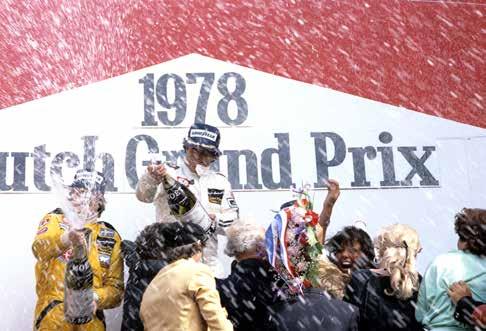
It was in a state of mutual desperation that Colin Chapman, Lotus’s founder and presiding genius, and Andretti met for breakfast at their hotel during the Long Beach Grand Prix in 1976. Lotus’s last win had come two years earlier, while Andretti, America’s leading driver, had just learned that the Parnelli team, with which he had spent two frustrating years, would be pulling out of F1 after only three rounds of the new season.
The two men knew each other well. The 47-year-old Chapman, who had trained as a civil engineer before starting his career in motor racing with a home-made special built around a pre-war Austin 7. The Italian-born Andretti, 36, had emigrated to the US with his family in childhood; he had won America’s premier single-seater championship by the time Chapman gave him his first experience of F1 with a handful of races in 1968 and 1969. Now, both at a low ebb, they made plans for a reunion. At the next race, a month later, Andretti would be in one of Chapman’s cars. The Lotus 77 was a stop-gap design, but the presence of the forceful American helped inspire development work that led to his first victory for the team in that year’s final round, under the slopes of Mount Fuji.
A new car, the Lotus 78, was ready for the following season, boasting a significant innovation. Its design made pioneering use of a shaped underbody to generate downforce, borrowing from a principle Chapman had spotted when studying the wing-mounted radiators of the wartime De Havilland Mosquito, where the expelled air had been used to provide lift. Chapman realised that if
the design were inverted, it could be used to pull the car downwards, increasing the grip of the tyres and therefore the speed at which corners could be taken.
Chapman’s technical team – including the former BRM men Tony Rudd and Peter Wright, chief designer Ralph Bellamy and vehicle engineer Martin Ogilvie – had spent time at Imperial College in London, where for the first time the design of an F1 car was refined by putting it on a rolling road inside a wind tunnel. By the time they returned to Long Beach, 12 months after their breakfast negotiation, it was effective enough to give Andretti the first of the four wins that took him to third place in the 1977 drivers’ standings.
After further investigation into what had become known as ‘ground effect’, the team produced a car for 1978 that would relegate its rivals to the status of museum exhibits. To the uninitiated, the smooth lines of the new Lotus 79 looked simply like the latest, most aesthetically ravishing development of conventional aerodynamic theory, which concentrated on providing the least possible hindrance to the air flowing over and around the bodywork at speed. But the 79’s precious secrets were hidden beneath its shapely bodywork, in the rectangular tunnel formed by the space each side, between its wheels.
Designing the whole car around this theory required removing obstructions from that underbody space in order to increase the volume and speed of the air flowing through it, creating a low-pressure zone that induced downforce. Where the previous design had split the fuel load between twin tanks located in the sidepods, now the cockpit was moved forward to make space for a single 30-gallon fuel tank between the driver’s back and the

| Bonhams Magazine 60
Above Champagne’s on me. Mario Andretti celebrates his win in the Lotus-Cosworth Type 79 Chassis no. 4 to be offered in Abu Dhabi Auction in November
Right & above right 1978 John Player Special Lotus-Cosworth Type 79 Chassis no. 4 JPS22
-
© Getty Images
mid-mounted Ford Cosworth DFV engine, whose exhaust pipes, formerly positioned under the car’s tail, were rerouted to emerge through the upper rear bodywork. And now there were pendent skirts running along the bottom edges of the sidepods, staying in contact with the ground and eliminating spillage, channelling the airflow out between the rear wheels.
hands of Niki Lauda, the other teams lodged protests, claiming that the fan contravened the prohibition on ‘movable aerodynamic devices’. The governing body agreed and effectively banned the car, allowing Andretti and Peterson to resume the 79’s run of success. The Swede won in Austria and the American in France, Germany and the Netherlands.
In another pre-echo of the cars that Max Verstappen and Lewis Hamilton will race in Abu Dhabi, increased sophistication extended to the cockpit, where the drivers were offered a greater range of adjustments that could be made during the race. Jenkinson noted Chapman’s latest wheeze: the introduction of a brake-balance control. “This means that Andretti now has eight things to play with in the cockpit: three pedals, a steering wheel, gear lever, rear roll-bar control, front roll-bar control and brake-balance control. Never a dull moment in the number one Lotus 79!”
The crushing wins in Belgium and Spain forced other designers to try their own variations on the new theme of ground effects. Over at Bernie Ecclestone’s Brabham team, the young South African designer Gordon Murray immediately built a car in which a large fan, mounted vertically at the rear, sucked air from under the car. When it walked away with the next race, in the

Andretti clinched the drivers’ title at Monza on a day of tragedy. In a multiple pile-up immediately after a chaotic start, Peterson suffered injuries to which he would succumb that night. When the race resumed after a two-hour delay, Andretti – at the wheel of Lotus 79/ 4, the fourth and last 1978 chassis to be built, in which he had won the previous race at Zandvoort – was first to the chequered flag, only to be relegated to sixth place for having jumped the restart. It was enough, even with two rounds of the series remaining, to secure his title.
For all the sadness of the race’s postscript, the combination of an extraordinary design and two brilliant drivers had restored the team’s fortunes. The memory of the four occasions on which the charismatic black-and-gold cars finished first and second, running around the circuits of Europe in triumphant tandem, would stand as the symbol not just of a car, or its drivers, or a team, but of an era.
Sale: On the Grid: The Abu Dhabi Auction Place: Abu Dhabi, Yas Marina Circuit Saturday 25 November at 9pm
Enquiries: Mark Osborne +1 415 503 3353 mark.osborne@bonhams.com
Bonhams Magazine | 61
Richard Williams’s most recent book is 24 Hours: 100 Years of Le Mans
“The memory of the charismatic black-and-gold cars running in tandem… is the symbol of an era”
The Marine Sale
London
Wednesday 18 October 2pm
Charles Murray Padday (British, 1868-1954)

Nearing the Mark (detail)
signed 'C. M. PADDAY -' (lower right)
oil on canvas 47 x 66.4cm (18½ x 26⅛in)
Estimate: £30,000 - 50,000 ($40,000 - 65,000)
Enquiries: Rhyanon Demery +44 (0) 20 7393 3865 rhyanon.demery@bonhams.com
The full English
Sometimes it takes an outsider to have the vision. In the case of three Sussex vineyards, it was family members brought up abroad who saw the potential in the chalk soil and coastal Sussex microclimate. The next step was being brave enough to say, “What about ripping up what we’ve been doing, and pouring all our money into wine?”
With a few exceptions, and not forgetting the Romans, wine in England has been only produced with commercial success since the 1990s. But in the past decade, it has impressed even the French. For example, six years ago, the house of
a while, but in 2006 a 16-acre site was planted with the three classic Champagne grapes – Pinot Noir, Pinot Meunier and Chardonnay – and a first vintage followed in 2008. Kirsty, Pip’s daughter-in-law, and her husband Richard have now taken over management of the estate and are producing take-on-all-comers sparkling wine. “Crisp green apples and freshly baked bread”, said Decanterabout its 2014 Brut. As Kirsty says, “We are experiencing the same weather that the French had in Champagne and Burgundy 40 years ago, which is one reason everyone is paying attention.” The Gorings have also seen the allure of turning the vineyard into a destination, so that fresh produce from Sussex is served in its restaurant Chalk, complete with tea-towel selling gift shop.
Ashling Park estate has – if possible – gone even further along the route of wine experience-cum-theme-park. With accommodation designed by William Hardie (off TV’s AmazingSpaces) and gin-making courses for rainy days, Ashling Park is fun for all the family. However, one mustn’t forget that it also produces wellregarded wine. Gail Gardner, who was brought up in Switzerland, asked her father if she could use a 33-acre hay meadow to make wine. It now yields more than 80 tonnes of grapes and produces 60,000 bottles of sparkling wine a year. The nonvintage Blanc de Blancs, in particular, has energetic lemon-zest notes.
With molten heatwaves in Europe, the Sussex wine trail certainly has legs.


Taittinger arrived from Reims to put a stake in some terroirin Kent, which shares with Sussex the geological seam of chalk that disappears under the Channel to pop up in Champagne. However, it didn’t need the French to point this out.
The Goring family have been farming their estate, Wiston – sited in the nearest National Park to London – for 250 years. Recently it was a turkey farm, but Pip, who married Harry Goring in 1972, always dreamt of a vineyard to remind her of her home in the Southern Cape. It took
Nearby, Tinwood took a similar approach. The estate – only three miles from the sea – was taken over by Art Tukker in 2006 from his father, a Dutch farmer, who had acquired it 40 years ago to grow the then revolutionary iceberg lettuce. Having studied winemaking in New Zealand, Art ripped up the lettuces and found the top soil of flint, gravel and loam over the layer of chalk was perfect for wine. This part of Sussex is perfectly positioned for growing vines, too. With the Isle of Wight as a rain-break and protected by the South Downs, the estate also has the cooling breeze from the sea to form a particularly beneficial microclimate. Tinwood makes a rosé sparkling wine alongside an elegant Blanc de Blancs and a Brut, and like Wiston has a restaurant. There are wood lodges as well, with their own terraces set in the vineyard.
Lucinda Bredin is Editor of Bonhams Magazine
Sale: Fine Wine
London
Online from 26 September to 5 October
Enquiries: Richard Harvey MW +44 (0) 20 7468 5811 richard.harvey@bonhams.com
WINE
English fine wines aren’t just a success, says Lucinda Bredin, they’re an experience
“Six years ago, the Champagne house Taittinger put a stake in some terroirin Kent”
Left On the trail: Wiston and the South Downs
Below
Tinwood Estate: every grape is hand-picked
Expressionism: Germany, Austria and Beyond
London
Thursday 19 October
2pm
Paul Klee (1879-1940)
Ohne Titel (Häuser mit Baumallee)
Executed circa 1915 gouache and watercolour on paper
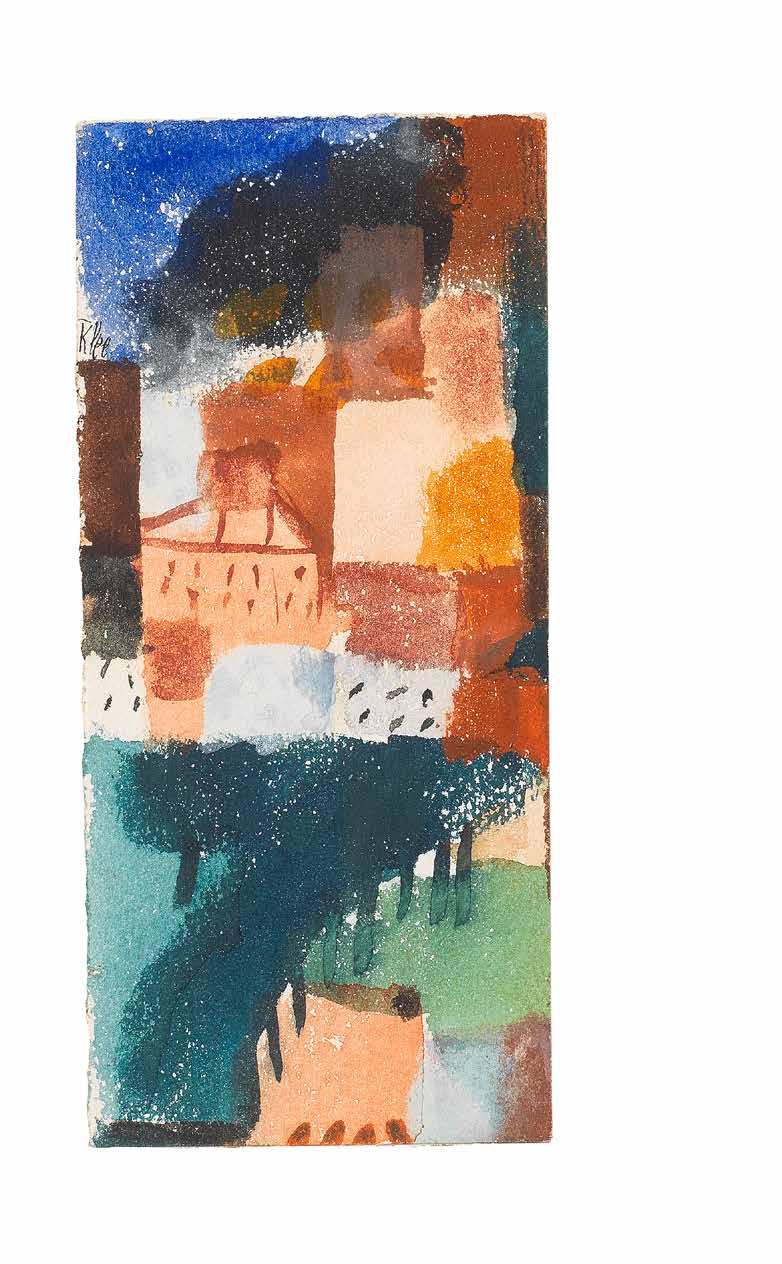
16.3 x 7.5cm (6½ x 2¾in)
Estimate: £120,000 - 180,000 ($150,000 - 230,000)
Enquiries: Frederick Millar +44 (0) 20 7468 8251 frederick.millar@bonhams.com
Around the
Globe
Sasha Thomas highlights a selection of Bonhams’ sales worldwide
Bruun Rasmussen North stars
From the early 1870s to the turn of the 20th century, a group of Danish and Scandinavian painters gathered each summer in the small fishing village of Skagen, on Denmark’s northernmost tip. Drawn to the region’s fishing community, pristine beaches, light and natural landscape, the group – which included Peder Severin Krøyer, his wife Marie Krøyer, Laurits Tuxen, Anna Ancher and her husband Michael Ancher – gathered at Brøndums Hotel to share ideas and discuss each other’s work. Inspired by French Impressionism, they preferred to paint en plein air, and shared a particular affinity for the light of the evening ‘blue hour’ – when sky and sea appear to merge. In rejecting the traditional approach of the Royal Academy in Copenhagen, the Skagen Painters came to represent ‘The Modern Breakthrough’ in Danish art. A dedicated sale of the group’s work will take place at Bruun Rasmussen this September.
Image: Michael Ancher (1849-1927), Two women in the sunset at Skagen beach

Estimate: DKK4,000,000 - 5,000,000
Sale: Northern Light – the Artists’ Colony at Skagen, 18 September

Enquiries: Julie Arendse Voss +45 8818 1123 jav@bruun-rasmussen.dk
Edinburgh Your toast
After the deposition of James II (James VII of Scotland) in the Glorious Revolution of 1688, supporters of the Stuart line, known as Jacobites, continued to fight for the restoration of the House of Stuart. Clinging to the idea of the Divine Right of Kings, they regarded the revolution as an afront to both God’s will and Scottish liberties. The final Jacobite rising of 1745 saw the rebels, led by the Stuart claimant to the throne ‘Bonnie Prince Charlie’, crushed at the Battle of Culloden. Though the battle is often seen as the formal end of the attempts at a Stuart restoration, many Jacobites did not give up hope, continuing to take pride in their identity. Wine glasses engraved with Jacobite symbols would be used to toast their beliefs and the ‘King across the water’ – a reference to the time that James II spent in exile and a phrase that was used long after his death. Rare examples of some of these glasses come to Bonhams Edinburgh in September.
Image: A rare, engraved Jacobite air-twist wine glass, c.1750

Estimate: £3,000 - 4,000
Sale: The Scottish and Celtic Sale, Edinburgh, 14 September
Enquiries: Gordon Mcfarlan +44 (0) 141 223 8866 gordon.mcfarlan@bonhams.com

Bonhams Magazine |
65
Paris
The great escape
Sometimes the pressures of daily life get a little too much and we can all do with a little escape. As early as the 1880s, with the expansion of rail travel, posters were aiming to capitalise on that feeling, aiming to attract upper-middle-class holidaymakers to seaside or mountain resorts, such as Monaco or Gstaad. Such posters reached their peak between the end of the First World War and the 1950s, when they were replaced by other forms of advertising. The great masters of the form – Hugo d’Alesi, René Péan, Roger Broders and Cassandre – were experts at capturing the allure of travel, as a fine selection of posters offered by Bonhams Cornette de Saint Cyr this autumn will demonstrate.
Image: M. Romoli, ABBAZIA, lithographic poster in colour, 1938


Estimate: €1,000 - 1,500
Sale: Affiches Anciennes de Collection, 27 September-4 October
Enquiries: Richard Barclay +33 625 572 389 richard.barclay@bonhams.com
Hong Kong Forever Yongle

The Ming court (1368-1644) was the most significant patron of Buddhist art in China. While it used Buddhism as a means to exert influence over Tibet and Mongolia, Buddhism was far more than just a political tool for some rulers. The Yongle emperor (1402-1424) favoured Confucianism, but nevertheless supported Taoism and Buddhism. Dozens of gilt copper alloy Buddhist sculptures were made under Yongle imperial patronage, each bearing the reign mark of the third Ming ruler, da Ming Yongle nian shi This important group of sculptures were either brought to Tibet as tribute by visiting Chinese dignitaries or given to Tibetan monks visiting the Yongle court. The bronzes were then sometimes regifted: during the Qianlong period (1736-1795), the Dalai Lama and Panchen Lama sent objects of the Yongle and Xuande periods as gifts to the Manchu ruler. This gilt copper alloy sculpture of Manjushri is offered by Bonhams Hong Kong in October for the final part of the Claude de Marteau Collection sale.
Image: A gilt copper alloy figure of Manjushri, Ming Dynasty, Yongle mark and period (1402-1424)

Estimate: HK$6,000,000 - 8,000,000
Sale: Claude de Marteau: The Final Journey 5 October
Enquiries: Edward Wilkinson +44 (0) 20 7468 8314 edward.wilkinson@bonhams.com

| Bonhams Magazine 66
Boston American classics
The collection of William Lippman reflects his deep and wide-ranging interest in all things American. In his home, paintings on maritime themes lived harmoniously with his vast collection of American furniture and decorative arts. Lippman’s deep appreciation of exceptional craftmanship is very evident in Bonhams Skinner’s single-owner sale of his collection, being offered this November. From the rococo splendour of Pennsylvania furniture to important weathervanes, the sale will showcase the collector’s keen eye for detail and impeccable taste.

Images: The drawing room
Estimate range: $200 - 150,000
Sale: The William Lippman Collection, 14 November
Enquiries: Chris Fox
+1 508 970 3137 christopher.fox@bonhamsskinner.com



Knightsbridge Timeless style
She was the designer who freed fashionable women from their corsets and, as ‘Coco’ Chanel, became one of the first fashion designers to be recognised across the world. Now, to coincide with the opening of the V&A’s ‘Gabrielle Chanel: Fashion Manifesto’ exhibition, Bonhams Knightsbridge will shine the spotlight on the world of Chanel with ‘The Art of Luxury: Chanel’, a sale dedicated to the craftmanship of the illustrious fashion house. Among the lots are an exceptional cream and gold silk jacket by Gabriel Chanel (1883-1971) herself, probably from her autumn/winter collection of 1966/67.
Image: A Gabrielle Chanel Haute Couture cream and gold silk jacket, probably Autumn/ Winter 1966/67

Estimate: £500 - 800
Sale: The Art of Luxury: Chanel, 11-21 September
Enquiries: Meg Randell +44 (0) 20 7393 3876 meg.randell@bonhams.com
New York Worth a watch
Actor, racing driver, style icon – Paul Newman was the epitome of cool. Not everyone can have his piercing blue eyes and effortless charm, but his watch is another matter. Coming to Bonhams Fine Watches sale in New York, the exceptional Rolex Daytona Chronograph ‘Paul Newman’ –a stainless steel bracelet watch made around 1965 – is considered one of the greatest vintage Rolexes. Introduced in 1963, this was both the first iteration of the Daytona and the first Daytona with an exotic dial, since named ‘the Paul Newman dial’ in reference to the watch the actor wore himself. It is believed Rolex only produced

between 2,000 and 3,000 exotic Daytona dials, hence this model’s cult status. The image of Paul Newman – leading lady on one arm and this watch on the other – has lost none of its iconic cool, and now it can be yours too.
Image: Rolex Ref. 6239, ‘Paul Newman’ 1463435 (Client ref. R-006)
Estimate: $150,000 - 250,000
Sale: Fine Watches, New York, 18 October
Enquiries: Nate Borgelt + 1 323 4365 406 nate.borgelt@bonhams.com
Bonhams Magazine |
67
Zoute Making an impression
Charles Faroux (1872-1957) certainly knew his cars – he was an automotive engineer, a racing driver, the race director of 24 Hours of Le Mans and the editor of La Vie Automobile. In 1929, he made the wise choice of ordering a Bugatti Type 37 Grand Prix for the exceptionally low price of 40,500 francs (approximately €100,000 in today’s money). Now that same car is set to be one of the highlights of The Zoute Sale in October, with an estimate of €1,000,000 - €1,400,000. Faroux did not hold on to his purchase for long, however. He sold it straight to his friend, the Impressionist painter René Durey. The artist was clearly pleased, keeping the car until his death in 1959.
Image: 1929 Bugatti Type 37 Grand Prix
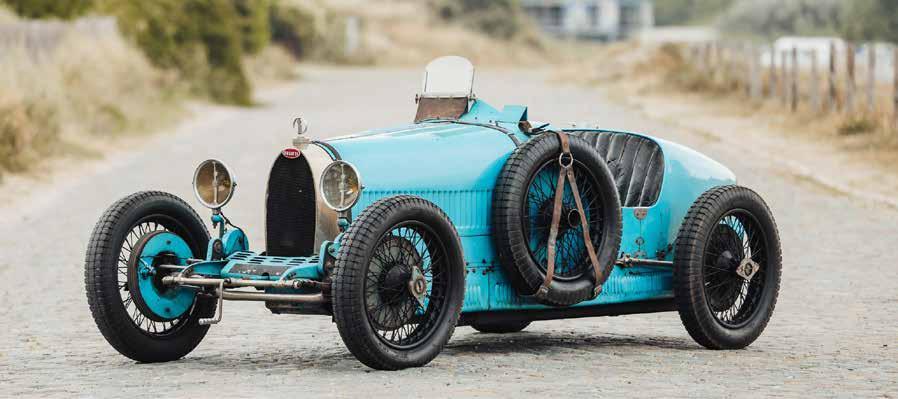
Estimate: €1,000,000 - €1,400,000
Sale: The Zoute Sale, 8 October Enquiries: Gregory Tuytens +32 4 7171 2736 gregory.tuytens@bonhamscars.com
Los Angeles
Precious thing
Ed Ruscha turns words and phrases into art. With a background in graphic design and an interest in advertising, his works are collages of meaning. A pioneer of the Pop Art movement, Ruscha is to California what Warhol was to New York. His works are often both alluring and mysterious, and Gem (1968), which leads the Post-War & Contemporary Art X Made in California sale in September, is no exception. Ruscha has said, “I read what I want to read. I think most people do that. Or I read what I want to see.” Now this gem is available for interpretation.
Image: Ed Ruscha (born 1937) Gem, 1968 (detail)
Estimate: $700,000 - 1,000,000
Sale: Post-War & Contemporary Art X Made in California, 13 September



Enquiries: Kate Rosenheim +1 323 436 5581 kate.rosenheim@bonhams.com
Los Angeles Marissa Speer
Bonhams has appointed Marissa Speer as Fashion Specialist and Head of Sale for the newly created Designer Handbags & Fashion department in the United States. Marissa will be based in Los Angeles and brings 20 years of experience in the luxury sector. Before joining Bonhams, she worked with the world’s largest consignment company The RealReal, driving sales and authenticating and valuing luxury fashion. The appointment builds on the success of Bonhams’ department for designer fashion and handbags, created in London in 2020 to cater to the increasing demand for pre-loved fashion already seen across Europe. Marissa’s first sale will take place in November.

Enquiries: Marissa Speer +1 323 436 5595 marissa.speer@bonhams.com

| Bonhams Magazine 68
The Greek Sale
Paris
Wednesday 22 November
2pm
Nikos Engonopoulos (1907-1985)
Hommage à C. Parthenis (detail)
1967
oil on canvas
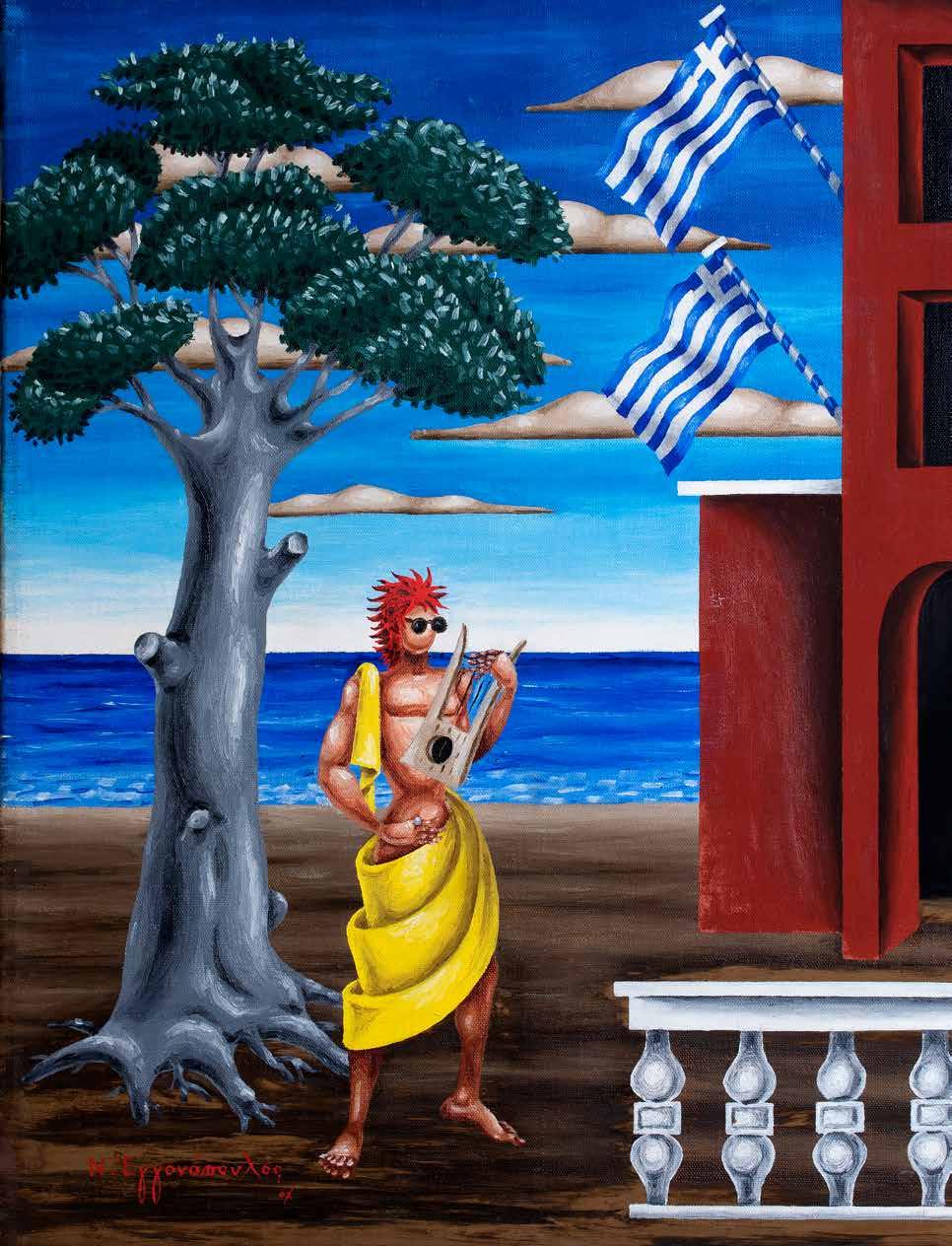
55 x 46cm (21 x 18in)
Estimate: €60,000 - 80,000
($65,000 - 90,000)
Enquiries: Anastasia Orfanidou +44 (0) 20 7468 8356
anastasia.orfanidou@bonhams.com
Bonhams Salerooms & Offices Worldwide
Bukowskis Arsenalsgatan 2 Box 1754, 111 87 Stockholm, Sweden
+46 8 614 08 00
Copenhagen
Bruun Rasmussen Bredgade 33 1260 Copenhagen, Denmark +45 8818 1111
MIDDLE EAST
AFRICA
Nigeria
Neil Coventry +234 (0) 8110 033 792 +27 (0) 7611 20171 neil.coventry@ bonhams.com
South Africa –Johannesburg
Penny Culverwell +27 (0) 71 342 2670 penny.culverwell@ bonhams.com
AUSTRALIA
Sydney 97-99 Queen Street, Woollahra, NSW 2025
Australia
+61 (0) 2 8412 2222
+61 (0) 2 9475 4110 fax info.aus@bonhams.com
Melbourne
1130 High Street
Armadale VIC 3143
Australia
+61 (0) 3 8640 4088
+61 (0) 2 9475 4110 fax info.aus@bonhams.com
ASIA
Beijing Vivian Zhang Unit C610, Beijing Lufthansa Center, 50 Liangmaqiao Road, Chaoyang District, Beijing 100125, China
+86 (0) 10 8424 3188 beijing@bonhams.com
Shanghai
Wang Jie Room 409,4th Office Building, International Equatoral Hotel No.65, Yan An Road West, Jing An District Shanghai 200040, China
+86 (0) 21 6248 0258 shanghai@bonhams.com
Singapore Yunwen Sung
11th Floor, Wisma Atria 435 Orchard Road
Singapore 238877
+65 (0) 6701 8038
+65 (0) 6701 8001 fax yunwen.sung@bonhams. com
Taipei
Bobbie Hu
Suite 2012, 20F, No. 333, Section 1 Keelung Road Xinyi District, Taipei City 110, Taiwan +886 2 2757 7070 taiwan@bonhams.com
EUROPE
Belgium
Wilfrid Vacher
Christine de Schaetzen
Chaussée de Charleroi, 89
1060 Brussels
+32 (0) 2 880 73 80
+32 (0) 2 736 50 76 belgium@bonhams.com
France
Catherine Yaiche catherine.yaiche@ bonhams.com
6 avenue Hoche 75008 Paris
+33 (0) 1 42 61 10 10 paris@bonhams.com
Germany – Cologne
Andrea von Bredow +49 152 021 562 01 andrea.vonbredow@ bonhams.com cologne@bonhams.com
Germany – Düsseldorf and Northern Germany
Eva Lengler +49 176 698 580 73 eva.lengler@bonhams.com dusseldorf@bonhams.com
Germany – Frankfurt
Andrea von Bredow +49 69 509 55 209 andrea.vonbredow@ bonhams.com frankfurt@bonhams.com
South of Germany – Münich & Austria
Katharina Upmeyer Maximilianstrasse 52 80538 Münich +49 (0) 89 2420 5812 katharina.upmeyer@ bonhams.com munich@bonhams.com
Greece
Philippe-Stratis Glyptis art@expertise.gr 7 Neofytou Vamva Street Athens 10674 +30 (0) 210 3636 404 athens@bonhams.com
Ireland Kieran O’Boyle kieran.oboyle@ bonhams.com
31 Molesworth Street
Dublin 2 +353 (0) 1 602 0990 ireland@bonhams.com
Italy – Milan
Benedetta Alpini benedetta.alpini@ bonhams.com
Via Boccaccio 22 20123 Milano +39 0 2 4953 9020 milan@bonhams.com
Italy – Rome
Emma Dalla Libera emma.dallalibera@ bonhams.com
Via Sicilia 50 00187 Roma
+39 06 485 900 rome@bonhams.com
The Netherlands
Charlotte Roelofsen charlotte.roelofsen@ bonhams.com
De Lairessestraat 154 1075
HL Amsterdam
+31 (0) 20 67 09 701 amsterdam@ bonhams.com
Portugal Filipa De Andrade filipa.deandrade@ bonhams.com
Rua Bartolomeu Dias
no160. 1, Belem 1400-031 Lisbon
+351 218 293 291 portugal@bonhams.com
Spain – Barcelona & North Teresa Ybarra
teresa.ybarra@ bonhams.com
+34 930 156 686
+34 680 347 606 barcelona@ bonhams.com
Spain – Madrid
Johann Leibbrandt johann.leibbrandt@ bonhams.com
Núñez de Balboa no 4-1C 28001 Madrid
+34 915 78 17 27
Switzerland – Geneva Katie Kennedy katie.kennedy@ bonhams.com
Rue Etienne-Dumont 10 1204 Geneva +41 22 300 3160 geneva@bonhams.com
Switzerland – Zurich Andrea Bodmer andrea.bodmer@ bonhams.com
Stockerstrasse 12 8002 Zürich
+41 44 281 9535 zurich@bonhams.com
NORTH AMERICA
USA
Representatives: California –Palm Springs Brooke Sivo brooke.sivo@ bonhams.com
+1 (760) 567 1744 palmsprings@ bonhams.com
California – San Diego Brooke Sivo brooke.sivo@ bonhams.com
+1 (760) 567 1744 sandiego@ bonhams.com
Florida Kate Stamm kate.stamm@bonhams.com
+1 (561) 319 2586
Luis Torres luis.torres@bonhams.com
+1 (929) 215 1621 miami@bonhams.com
Illinois & Midwest
Natalie B Waechter natalie.waechter@ bonhams.com
+1 (773) 267 3300 chicago@bonhams.com
Nevada – Las Vegas Brooke Sivo brooke.sivo@ bonhams.com
+1 (760) 567 1744 lasvegas@bonhams.com
Oregon & Idaho
Sheryl Acheson sheryl.acheson@ bonhams.com
+1 (971) 727 7797 oregon@bonhams.com
San Francisco 601 California Street Suite 150 San Francisco CA 94108
+1 (415) 861 7500 info.us@bonhams.com
Texas – Dallas & Houston Mary Holm mary.holm@bonhams.com
+1 (214) 557 2716 Brandon Kennedy brandon.kennedy@ bonhams.com dallas@bonhams.com
Washington & Alaska
Heather O’Mahony heather.omahony@ bonhams.com
+1 (206) 566 3913 seattle@ bonhams.com
Canada
Toronto, Ontario
Kristin Kearney 340 King St East Toronto ON M5A 1 KB kristin.kearney@ bonhams.com +1 (416) 462 9004 info.ca@bonhams.com
Representatives: Vancouver, BC Cailin Broere cailin.broere@ bonhams.com +1 (604) 841 7315 info.ca@bonhams.com
Israel Joslynne Halibard joslynne.halibard@ bonhams.com +972 (0) 54 553 5337
UNITED KINGDOM
South East England Brighton & Hove
Representative: Tim Squire-Sanders +44 1273 220 000 hove@bonhams.com
Guildford Millmead, Guildford, Surrey GU2 4BE +44 1483 504 030 guildford@ bonhams.com
Isle of Wight +44 1273 220 000 isleofwight@ bonhams.com
West Sussex +44 (0) 1273 220 000 sussex@ bonhams.com
Thames Valley
Oxford Banbury Road Shipton on Cherwell Kidlington OX5 1JH +44 1865 853 640 oxford@ bonhams.com
South West England
Bath Queen Square House Charlotte Street Bath, BA1 2LL +44 1225 788 988 bath@bonhams.com
Dorset
Representative: Emma Sykes +44 1225 788 982 bath@bonhams.com
Exeter Richmond Court, Emperor Way, Exeter, Devon, EX1 3QS +44 1392 425 264 exeter@bonhams.com
Tetbury Eight Bells House 14 Church Street Tetbury
Gloucestershire GL8 8JG +44 1666 502 200 tetbury_office@ bonhams.com
Truro 36 Lemon Street Truro TR1 2NR +44 1872 250 170 truro@bonhams.com
Midlands
Knowle 21B Station Road Knowle, West Midlands B93 0HL +44 1564 776 151 knowle@ bonhams.com
Yorkshire & North East England
Leeds, North East, Lincolnshire & Nottinghamshire The West Wing Bowcliffe Hall Bramham Leeds, LS23 6LP +44 113 234 5755 leeds@bonhams.com
East Anglia
Bury St Edmunds
Representative: Michael Steel +44 1284 716 190 bury@bonhams.com
Norfolk and South Lincolnshire
Representative: Claire Tuck +44 1603 871 443 norfolk@ bonhams.com
North West England Chester, North West and North Wales 2 St Johns Court Vicars Lane Chester, CH1 1QE +44 1244 313 936 chester@ bonhams.com
Manchester Representative: Antony Bennett +44 161 927 3822 manchester@ bonhams.com
Channel Islands
Guernsey
Representative: Angela Peel +44 1481 722 448 guernsey@ bonhams.com
Jersey La Chasse La Rue de la Vallée St Mary Jersey, JE3 3DL +44 1534 722 441 jersey@bonhams.com
Scotland
Glasgow/West of Scotland
Representative: Gordon McFarlan +44 141 223 8866 glasgow@ bonhams.com
Wales
Cardiff
Representative: Emma Sykes +44 292 072 7980 cardiff@bonhams.com
INTERNATIONAL SALES DIARY
All sale dates are subject to change. Readers are advised to contact the department concerned for exact details. For information and details of sale dates, or about the objects and paintings pictured, please contact Customer Services at Bonhams New Bond Street on +44 (0) 20 7447 7447. Please note: London 101 New Bond Street London W1S 1SR +44 (0) 20 7447 7447 Montpelier Street London London SW7 1HH +44 (0) 20 7393 3900 Paris Bonhams Cornette de Saint Cyr 6 avenue Hoche +33 (0) 1 42 61 10 10 Brussels Bonhams Cornette de Saint Cyr 89 Chaussée de Charleroi 1060 Brussels +32 (0) 2 880 73 80 New York 580 Madison Avenue New York, NY 10022 +1 (212) 644 9001 Los Angeles 7601 W Sunset Boulevard Los Angeles CA 90046 +1 (323) 850 7500 Boston Bonhams Skinner Marlborough 274 Cedar Hill St, Marlborough MA 01752 +1 508 970 3000 Bonhams Skinner 63 Park Plaza, Boston MA 02116 +1 508 970 3211 Hong Kong 20/F One Pacific Place 88 Queensway Admiralty, Hong Kong +852 2918 4321 Edinburgh 7 Melville Crescent Edinburgh EH3 7JA +44 131 225 2266 Sydney 97-99 Queen Street, Woollahra, Sydney NSW 2025 +61 2 8412 2222 Stockholm
70 | Bonhams Magazine
Modern and Contemporary South Asian Art
London
Tuesday 14 November
1pm
Rabindranath Tagore (Indian, 1861-1941)
Untitled (Dark landscape with cliffs and tree) (detail)
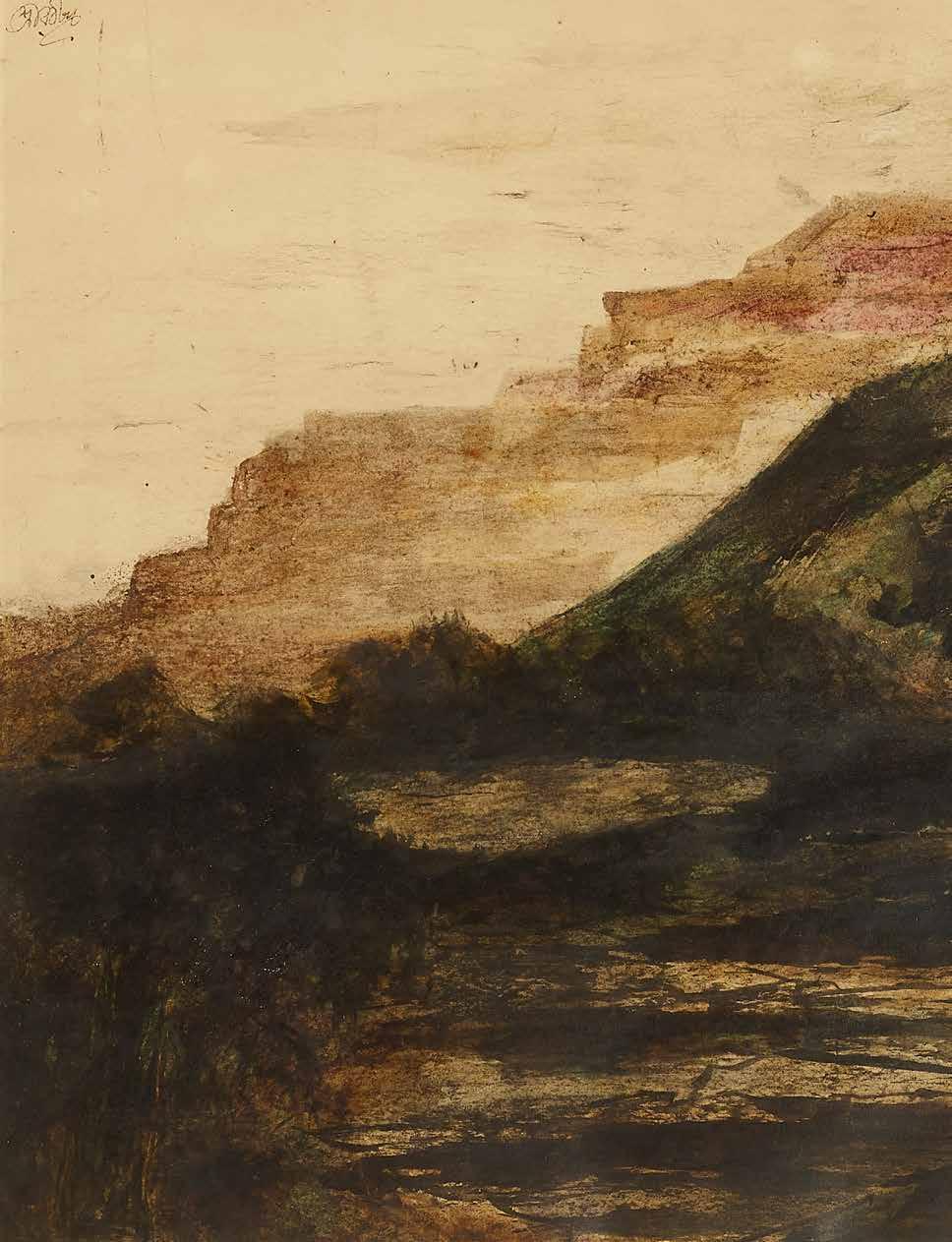
circa 1920s
watercolour on paper, framed 36 x 38.5cm (14.25 x 15.25in)
Estimate: £40,000 - 60,000 ($50,000 - 80,000)
Enquiries: Priya Singh
+44 (0) 20 7468 8203 priya.singh@bonhams.com
My Favourite Room
Palais Stoclet in Brussels, where I was born and lived for 15 years, is regarded as one of the most extraordinary houses ever built. It has been listed in several stages: exterior, interior, garden, and finally the furniture and silver. It was also listed by UNESCO. It has been called, ironically, a ‘gilded cage’.
My grandfather, Adolphe Stoclet, commissioned it in 1904. Having spent time in Vienna, he met all the artists of the Vienna Secession, among them Kokoschka, Klimt and Schiele, as well as Mahler and Secession architect Josef Hoffmann, whom he commissioned to build this stunning home.

The house, with its austere geometric forms, is on Avenue de Tervueren. My grandfather, being an heir to a considerable fortune, gave Hoffman carte blanche, which was highly irresponsible. Hoffmann even designed a dress for my grandmother, so she wouldn’t clash with the decor.
The crowning glory of the Palais are Gustav Klimt’s mosaic friezes in what became the large dining room. They are so elaborate that Klimt himself wrote a letter to Hoffmann saying the design was unrealistic, as it would be too expensive.
I remember asking my grandfather, as we were going down the main stairway for lunch, how much the house cost. He just laughed. I don’t think he knew himself.
My father passed away when he was 33 and we stayed with my grandparents during my mother’s widowhood, which lasted 12 years. So every day we had lunch and dinner with my grandparents.
The large dining room with the Klimt friezes was only used at Christmas – with 20 or more around the table – and for
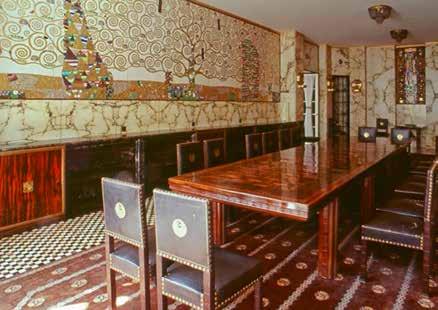

we chatted and looked at his vitrines, which were filled with works of art, like a cabinet of curiosities.
The other thing I remember was the hall that was hung with Italian primitive paintings, of which there were more than 50. Some were placed in a reserve room. When collectors or museum directors came to see them, the butler brought the paintings one by one so that they could look at them at their ease. The pastel by Fernand Khnopff offered by Bonhams in October hung in my grandparents’ bedroom. They were very fond of it.

special events. For day-to-day occasions, we ate in the little dining room, as it was called, which I much preferred. This was the most convivial room in the Palais.
It made me feel relaxed and happy. That room and my grandfather’s study. After lunch we would go there and drink coffee while my grandfather smoked his one cigarette of the day. It was there that
The house was extraordinary, but there was no sense of reality. This made it uneasy for me, especially as I went to a public city school. My friends there teased me, as the boy who lived in the marble house. My mother remarried when I was 15, and we moved out to live in a house of bricks. It was one of the happiest days of my life.
Palais Stoclet, Avenue de Tervueren, Brussels. The house can only be viewed from the outside.
Sale: The Stoclet Collections
Bonhams Cornette de Saint Cyr, Brussels Monday 23 October
Enquiries: +32 2 880 73 80
bruxelles@cornette-saintcyr.com
| Bonhams Magazine 72
“I asked how much the house cost. My grandfather just laughed”
The palace where Philippe R. Stoclet grew up was an extraordinary home – and a ‘gilded cage’
Photo by PtrQs, CC BY-SA 4.0

Bonhams | Cars introduces a rebrand of its international motoring department, complete with a dedicated website for collector cars, motorcycles, and automobilia, which is live now at BonhamsCars.com. Buy and sell your collector car anywhere, anytime—live or online. Discover the new BonhamsCars.com
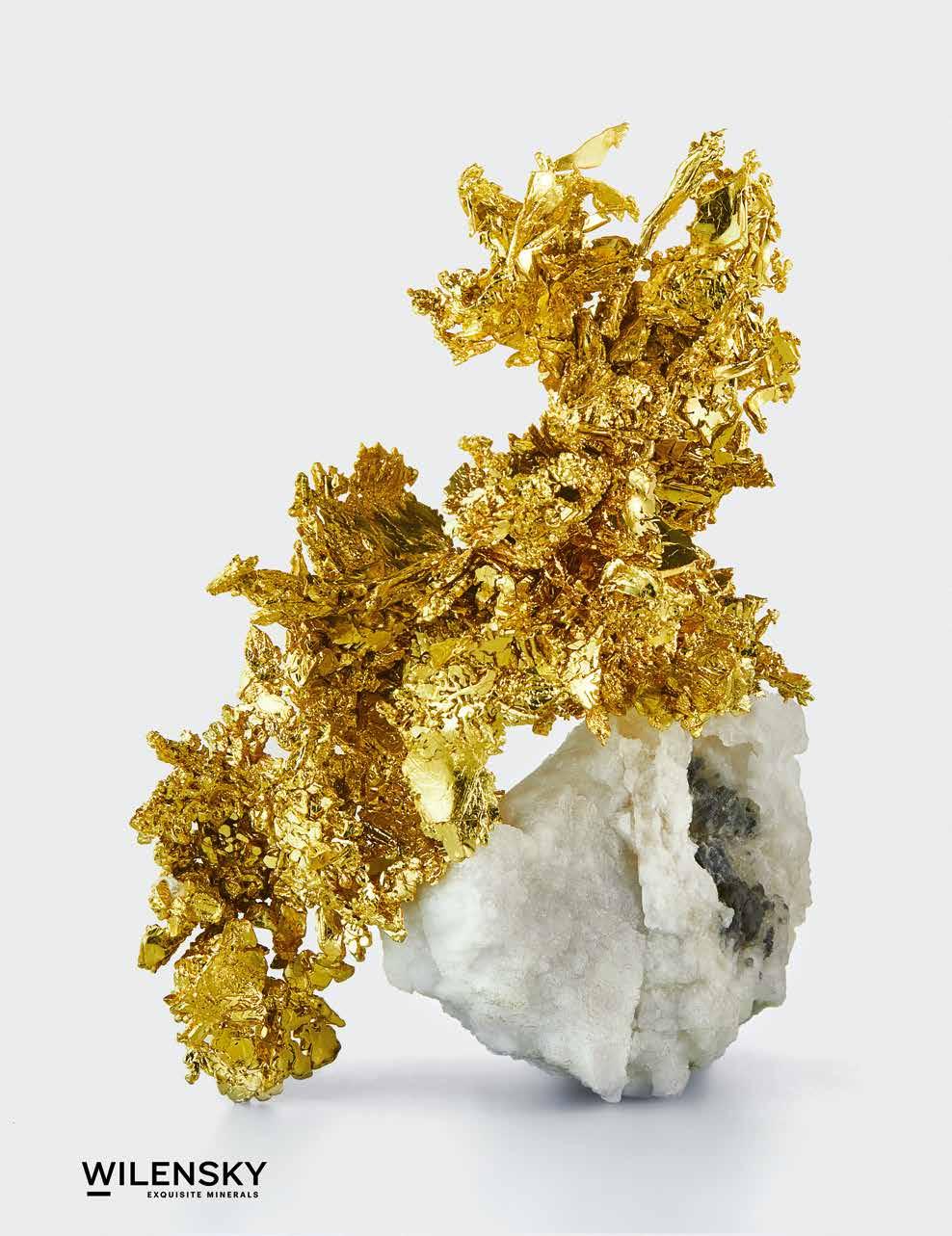














































































 Image courtsey of Atelier Hugo
Image courtsey of Atelier Hugo
















































 © Robert Mapplethorpe Foundation
© Robert Mapplethorpe Foundation








 © Philippe Morillon
© Philippe Morillon
© Philippe Morillon
© Philippe Morillon
© Philippe Morillon
© Philippe Morillon














































